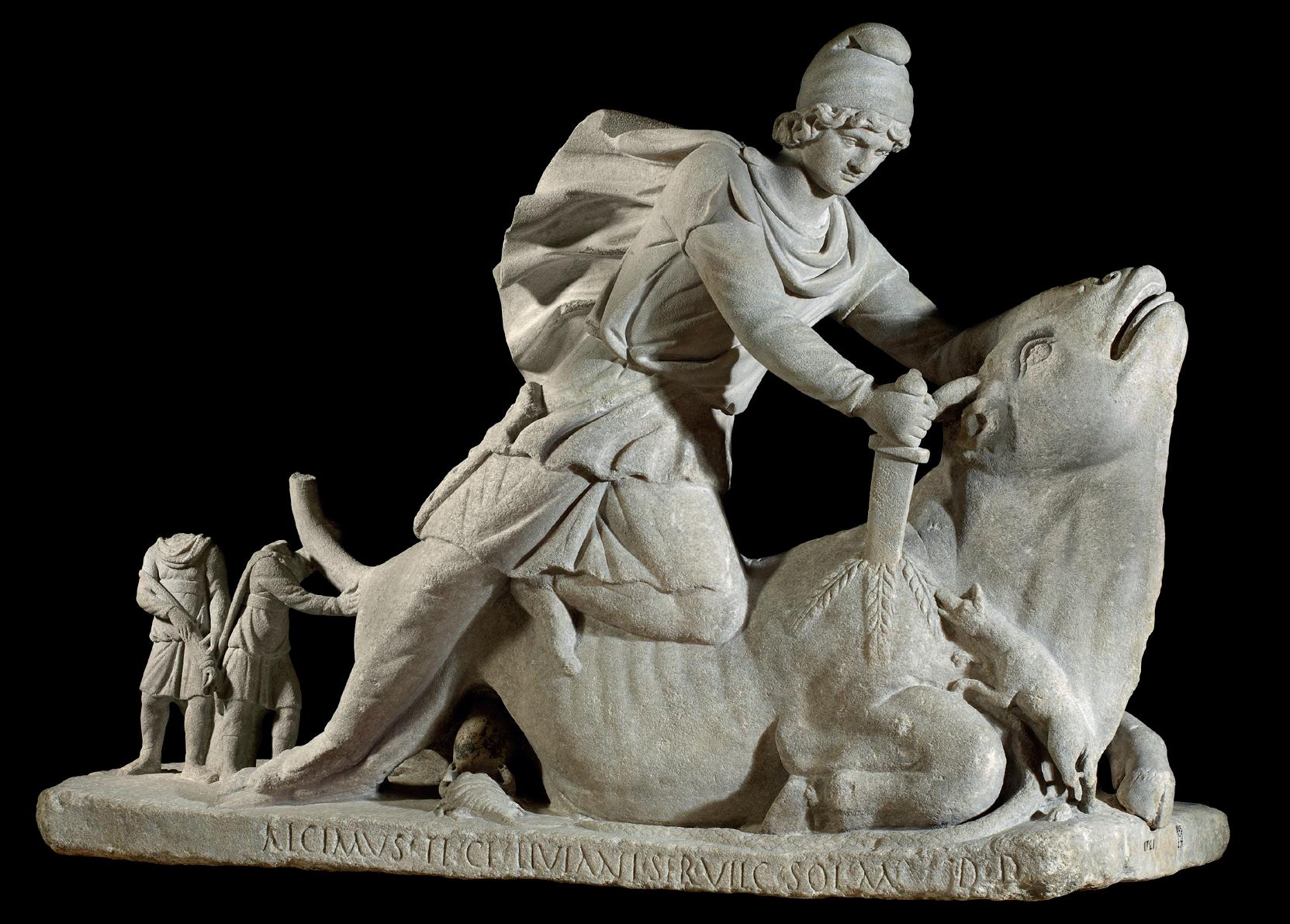




The Cambridge School Classics Project (CSCP) is part of the Faculty of Education at the University of Cambridge and has been supporting Classics education for over fifty years. CSCP comprises a small team of Classics education and technology specialists, supported by a wide community of educators and academics. All CSCP materials are based on the latest research, not only in Classics but also in language acquisition and educational theory.
While CSCP has numerous projects and initiatives supporting Classics education around the world, its first-ever undertaking – the Cambridge Latin Course (CLC) –remains its most successful and influential, leading the way in evidence-based teaching of Classical languages. The underlying course structure and inductive methods of the CLC have proven effective and adaptive, responding well to the ever-changing educational environment. Most of the funding which enables CSCP’s work comes from sales of the Cambridge Latin Course and associated products; therefore, every CLC purchase directly funds Classics educational research and development; grātiās!
Languages are all about communication, and learning a language enables you to access the culture of the people who use it. Latin is no different. It may not have been the language of daily life for thousands of years, but there are many literary and historical sources about Roman life that it can still unlock.
With this in mind, the Cambridge Latin Course has two main aims:
1 to teach you to understand Latin so that you can read Latin texts confidently
2 to develop your knowledge and understanding of Roman culture, especially in the first centur y AD.
The course is set firmly in a Roman context, and as you study you will meet real historical characters – as well as fictional ones – and learn about the social, political, and historical aspects of Roman culture.
Pay close attention not only to the text of the Latin stories and the section in English in each Stage, but also the many illustrations. These have been created or chosen to give you extra information about the Roman world and are meant to be looked at alongside the text.
The CLC uses a specific approach to language learning called the “Reading Method.” The basis of this method is, unsurprisingly, reading!
As you study with the course, you will read lots of Latin stories; this is so you get used to seeing Latin in action and focusing on its meaning, rather than just learning rules in isolation. The stories have been very carefully written so that you are introduced from the beginning to common Latin phrase and sentence patterns, with different Latin language features woven in gradually. It is important for you to understand how the Latin words that make up a sentence or phrase actually work, and equally important that you get into the habit of grouping words together and trying to understand whole phrases or sentences as a single unit.
When reading the stories, you can think about how the language works and perhaps answer questions on what you understood. Afterwards, you might consider how you were able to understand what was going on, or what patterns you have noticed in the language. By the time you study a particular point of Latin language, you may have seen it in action in the stories many times. You might even be able to explain how you think it works, rather than waiting for someone to tell you.
The CLC is made up of four textbooks, divided into Stages. As you work through the course, you will visit a variety of places in the Roman world: Pompeii, Roman Britain, Egypt, and the city of Rome itself.
Most Stages contain new language features, and all deal with a different aspect of Roman culture. The majority of them contain the following:
These tell a simple story using “cartoon strips” of pictures with short sentences or paragraphs which use the new language feature you will be learning about in that Stage.
The stories are the main way in which you will learn about the language and get used to reading it. They get longer and more complicated as you go through the course, and new vocabulary is given alongside. You might not be able to translate every word of a story, and that’s OK; the goal is for you to try to understand what is happening and get more confident at understanding passages of Latin.
This section gives you an explanation of language features that have been introduced or have occurred frequently in the Stage. It usually appears a few pages into the Stage and is designed to be studied after you have seen the language feature in the stories, so you might have already gotten some idea of how it works.
This contains another, shorter story which uses the language feature about which you have been learning. There are questions to check your understanding and encourage you to think critically about the story and the language. This section also contains links to the places in the textbook where you can find more information on the language.
This material explores an aspect of Roman culture that is important to the story line in the Stage. Each one is introduced by a question that you may want to think about as you read the material. The question appears again at the end of the section, with bullet points highlighting what you have learned and how this relates to the question. Throughout the material are questions, activities, and discussion ideas called Thinking points. You may not use all of them, but they can be a good opportunity to think more closely about what you have just learned.
At the end of each Stage, there is a list of common words which have appeared several times in the text with which you should now be familiar.
For extra help with the language, you need to check the Language information section at the back of the book. This is split into three sections.
This section summarizes the language content of the book (and in Units 2–4 the language features from previous books). It contains grammatical tables, notes, and additional exercises.
This section contains additional exercises for each Stage in the book. These exercises have been designed to help support you as you review language information – exercises are clearly labeled and numbered so that you can see your progress, and there are links to the places in the textbook where you can find additional support.
This section is where you will find the complete vocabulary for the whole book.
Throughout this book, BC and AD are used when referring to dates, as this is the system you are most likely to encounter in your wider studies of ancient history and Latin. This system was created in the sixth century AD and it uses the “birth of Jesus Christ” as its point of reference. Many other dating systems exist and have existed over the course of human history.
An easy alternative, if you do not want to use BC and AD, is that which uses BCE (Before Common Era) and CE (Common Era). This system uses the same point of reference as BC and AD, so you can simply swap BC for BCE and AD for CE.
Date Pompeii The Roman World The Wider World BC
2500–1500
1500–500c.700–600: Greek merchants settle in what was probably an older Oscan community
c.530: Etruscans control Pompeii
753: Traditional date of the foundation of Rome
509: Kings expelled; beginning of the Roman Republic
508: Roman–Etruscan Wars
c.2500: Great Pyramid at Giza completed in Egypt; Stonehenge built in England
c.2300: Babylon founded
c.2000–1200: Epic of Gilgamesh created in Mesopotamia
c.1750: Babylonian king Hammurabi proclaims one of the earliest written legal codes
c.1600: Minoan civilization at its height; evidence of a fully developed writing system in China
c.1000–800: Phoenician alphabet adapted by the Greeks; Homer’s Iliad and Odyssey orally composed
776: Traditional date of the first Olympic games
c.720: Building begins on the largest group of Nubian pyramids at Meroë
c.563–c.483: Suggested dates for the life of Siddhartha Gautama (The Buddha)
522–486: Persian Empire at its greatest extent; first attempted Persian invasion of Greece
508: Cleisthenes establishes the foundations of the Athenian democratic system
500–300474: Samnites capture Pompeii
450: The Law of the 12 Tables: foundation of Roman Law
390: Gauls sack Rome
343–304: First and Second Samnite and Latin Wars
399: Death of Greek philosopher Socrates
335–323: Conquests of Alexander the Great
300–200c.290: Pompeii becomes one of the socii (allies) bound to Rome by treaty
298–290: Third Samnite War: Romans control the whole Italian peninsula
264–241: First Punic War
218–201: Second Punic War
c.268–232: Almost all of the Indian subcontinent united under Emperor Ashoka the Great of the Mauryan Empire
221: China unified under First Emperor Qin Shi Huang
c.200Temple of Isis builtRome controls all of Italy Compass invented in China
200–100
192–188: War with the Seleucid Empire in Greece and Asia Minor
146: Third Punic War ends with destruction of Carthage
165: Judas Maccabaeus leads the Jewish defense against the Seleucid king and restores the Temple of Jerusalem (commemorated by the festival Hanukkah)
141–87: Reign of Chinese Emperor Wu; “Silk Road” established, connecting China via Asia to Europe until the eighteenth century
100–7091–89: Pompeii joins the Italians in the Social War; afterwards given Roman citizenship; Latin replaces Oscan as official language
80: Pompeii probably becomes a Roman colony
91–89: Social War
88–79: Sulla’s first civil war and dictatorship
73: Spartacus’ uprising
90–70: Probable date of the oldest extant Buddhist paintings found in the Ajanta Caves, India
70–50
60: Political alliance of Pompey, Julius Caesar, and Crassus
58–50: Caesar’s Gallic Wars
55 and 54: Caesar’s first and second invasions of Britain
53: Birth of Chinese poet Yang Xiong
50–40
49–45: Civil war between Caesar and Pompey
44: Julius Caesar assassinated
43: Triumvirate of Octavian, Mark Antony, and Lepidus established
48: Ptolemy XIII deposes his co-ruler and sister Cleopatra VII
47: Cleopatra VII restored to the throne
40–115: Major public works program instituted
AD
1–20
31: Octavian defeats Mark Antony and Cleopatra at the Battle of Actium
30: Province of Egypt organized
27: Octavian given the title “Augustus” and becomes the first emperor
14: Death of Augustus; Tiberius becomes emperor
30: Cleopatra, final Ptolemaic ruler of Egypt, takes her own life; by this point, the Mayan civilization has developed a symbol for zero
27: Amanirenas the Kushite Queen leads armies against the Romans
c.1: Beginning of explosive growth which leads to Teotihuacan becoming the largest settlement in Mesoamerica
c.4: Birth of Jesus; Traditional date for the foundation of the Ise Grand Shrine in Japan
20–30
30–40
40–50
26: Pontius Pilate made governor of Judea
37: Death of Tiberius; Caligula becomes emperor
41: Caligula assassinated; Claudius becomes emperor
43: Initial phase of Roman conquest of Britain
28: Beginning of the reign of Emperor Ming, during which Buddhism traditionally reaches China
c.30–33: Suggested date of the crucifixion of Jesus
39–40: The Trung sisters begin their rebellion against Chinese rule in Vietnam
43: The Trung sisters’ rebellion is defeated by Chinese forces
50–6059: Riot at the Pompeian amphitheater
60–7062/63: Earthquake damages Pompeii
69: Beginning of the restoration of the amphitheater
70–8079 Final elections held in March; Eruption of Vesuvius
54: Death of Claudius; Nero becomes emperor
60–61: Boudica’s revolt
64: Great Fire of Rome
69: Year of the Four Emperors: Galba, Otho, Vitellius, Vespasian
70: Siege of Jerusalem; Second Temple destroyed
73: Siege of Masada
79: Death of Vespasian; Titus becomes emperor
c.50: Death of Jewish philosopher Philo of Alexandria
68: China’s first Buddhist temple, White Horse Temple, is built
78: The beginning of the Saka Era used in traditional Indian calendars

Caecilius nōn est in vīllā. Caecilius in forō negōtium agit.
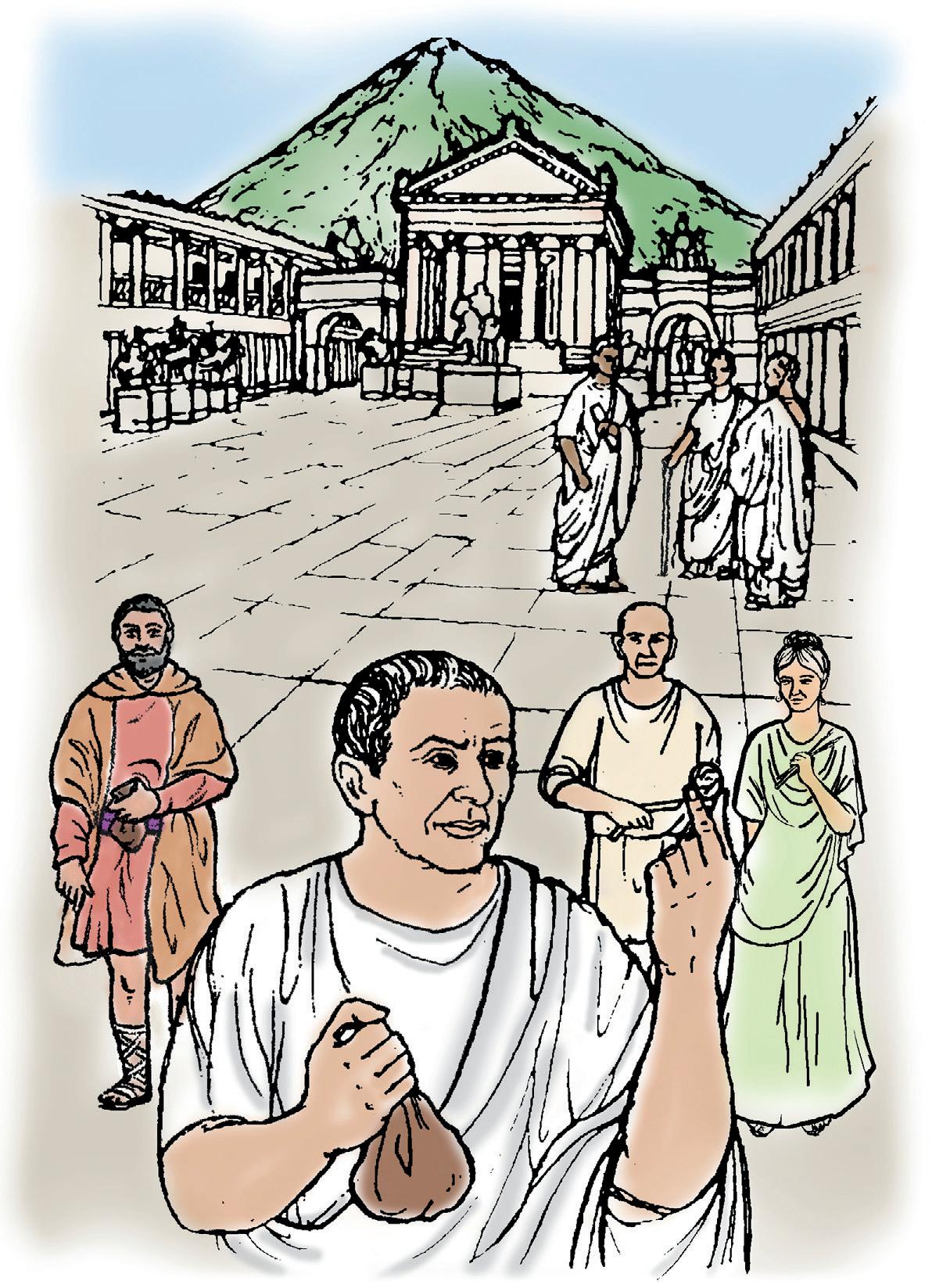
Caecilius est argentārius. argentārius pecūniam numerat.
Caecilius forum circumspectat. ecce! artifex in forō
ambulat. artifex est Clāra. Clāra Caecilium salūtat.
ecce! tōnsor quoque est in forō. tōnsor est Pantagathus.
Caecilius tōnsōrem videt.
“salvē!” Caecilius tōnsōrem salūtat.
“salvē!” Pantagathus respondet.
ecce! vēnālīcius forum intrat. vēnālīcius est Syphāx.
vēnālīcius mercātōrem exspectat. mercātor nōn venit.
Syphāx est īrātus. Syphāx mercātōrem vituperat.
in forō in the forum
negōtium agit is doing business
ecce! look!
artifex artist
ambulat is walking
tōnsor barber
vēnālīcius slave dealer, dealer in enslaved people
nōn venit does not come
artifex ad vīllam ambulat. artifex est Clāra. Clāra iānuam pulsat. Clēmēns artificem nōn audit. servus est in hortō.
Clāra clāmat. canis Clāram audit et lātrat. Quīntus canem audit. Quīntus ad iānuam venit. fīlius iānuam aperit. Clāra Quīntum salūtat et vīllam intrat.
Metella est in culīnā. Quīntus mātrem vocat. Metella ātrium intrat. artifex Metellam salūtat. Metella artificem ad trīclīnium dūcit.
Clāra in trīclīniō labōrat. Clāra pictūram pingit. magnus leō est in pictūrā. Herculēs quoque est in pictūrā. leō Herculem ferōciter petit. Herculēs magnum fūstem tenet et leōnem verberat. Herculēs est fortis.
Caecilius ad vīllam revenit et trīclīnium intrat. Caecilius fīliam vocat. fīlia ad trīclīnium venit. Lūcia pictūram intentē spectat et artificem laudat.

ad vīllam to the house, toward the house
iānuam pulsat knocks on the door
aperit opens
dūcit leads, takes pictūram pingit paints a picture
magnus leō big lion ferōciter fiercely petit is attacking fūstem tenet is holding a club verberat is striking fortis brave, strong revenit returns intentē closely, carefully
Popular subjects for wall paintings in Roman houses include scenes from mythology, gardens and animals, and portraits: a scene from Greek mythology showing Iphigenia, the daughter of the Greek king Agamemnon, found on the wall in Caecilius’ tablinum (above, left); cupids working as goldsmiths from The House of the Vettii (above, right); a cubiculum in the House of the Orchard in Pompeii covered in garden scenes with birds, plants, statues, fountains, and decorative plaques displaying Egyptian motifs (right).
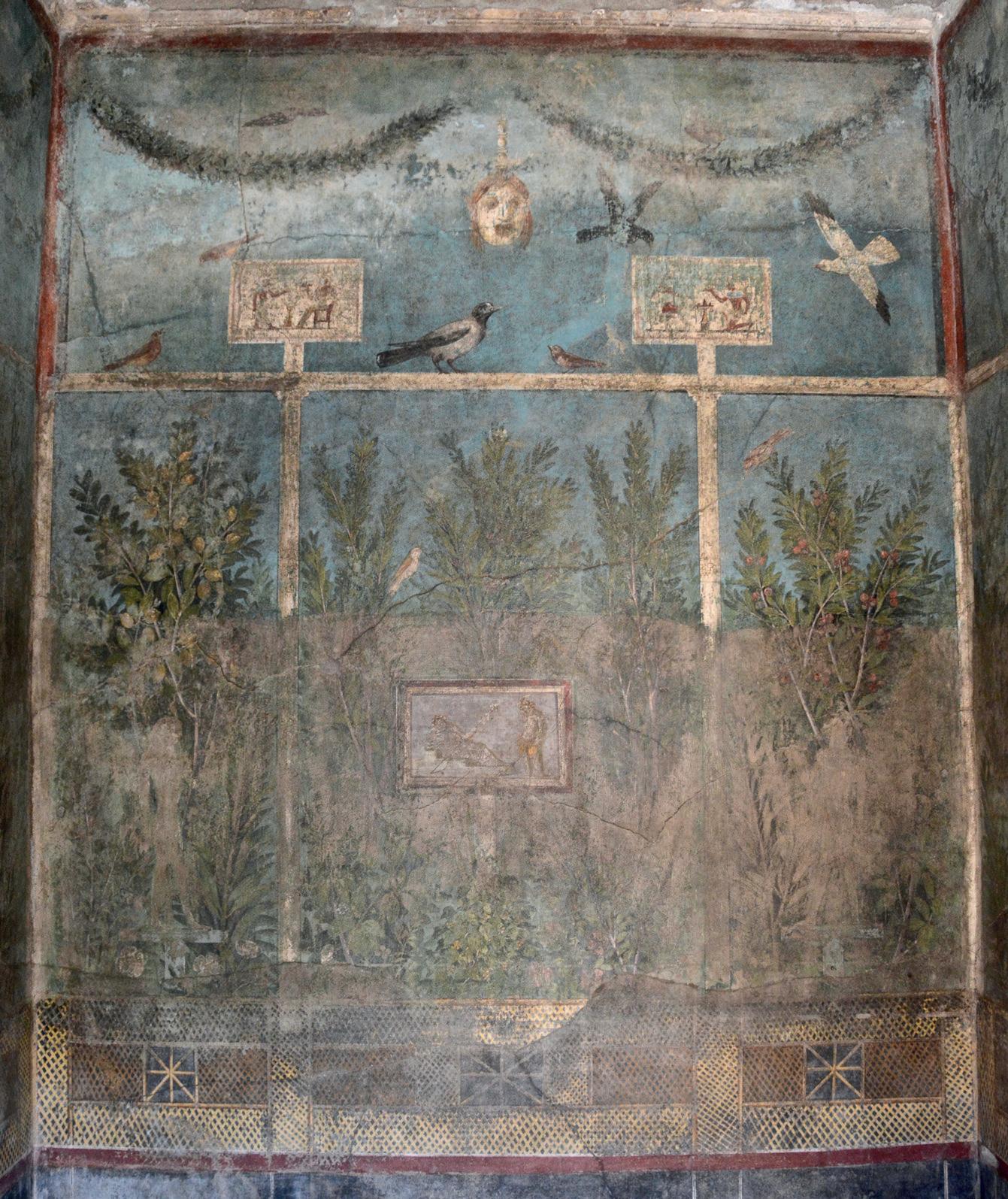
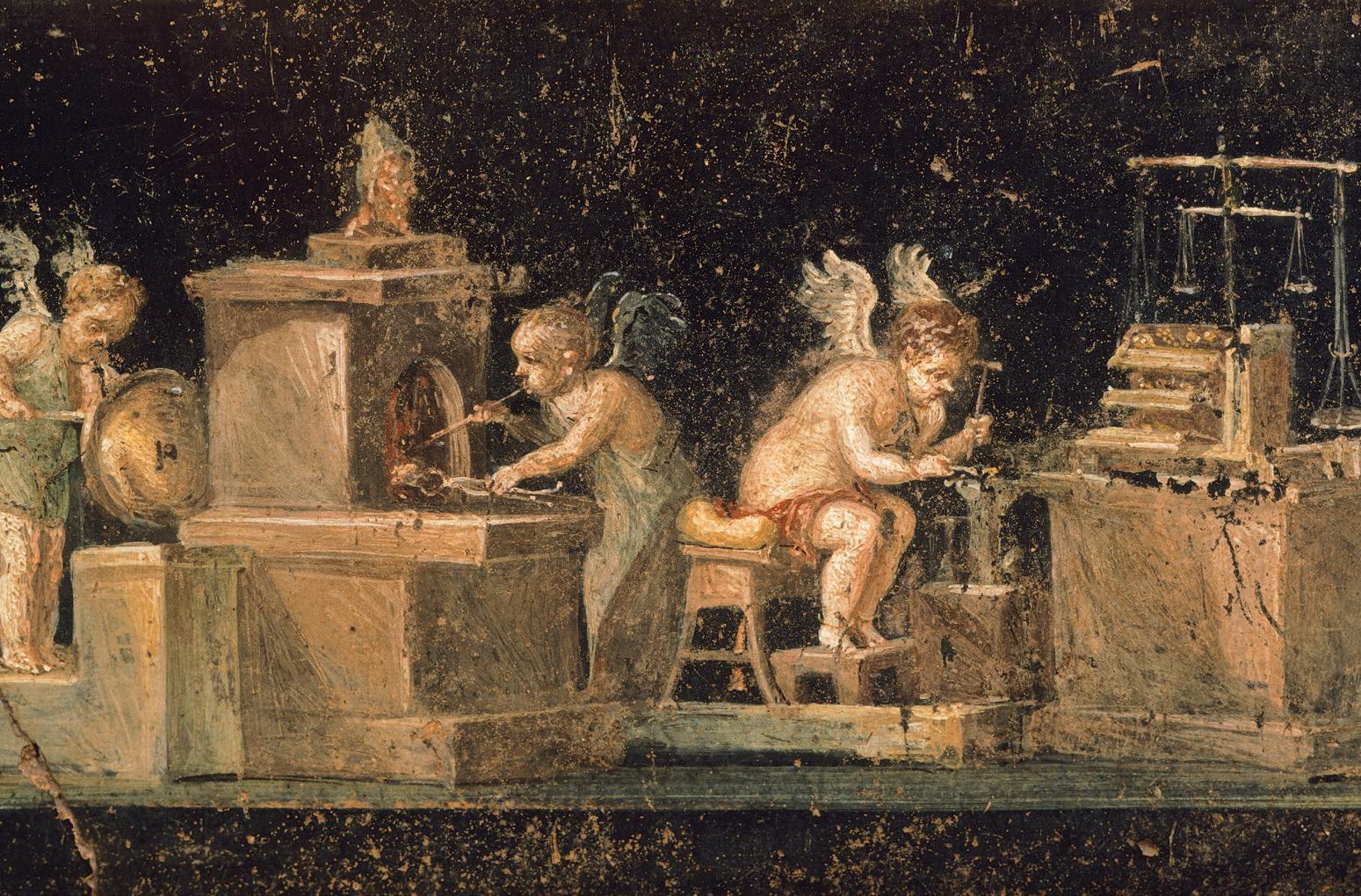

When you have read this story, answer the questions at the end. Answer in English unless you are asked for Latin.
tōnsor in tabernā labōrat. tōnsor est Pantagathus. Caecilius intrat.
“salvē, tōnsor!” inquit Caecilius.

“salvē!” respondet Pantagathus.
tōnsor est occupātus. senex in sellā sedet. Pantagathus novāculam tenet et barbam tondet. senex novāculam intentē spectat.
poēta tabernam intrat. poēta in tabernā stat et versum recitat. versus est scurrīlis. Caecilius rīdet. sed tōnsor nōn rīdet. tōnsor est īrātus.
“furcifer! furcifer!” clāmat Pantagathus. senex est perterritus.
tōnsor barbam nōn tondet. tōnsor senem secat. multus sanguis fluit.
Caecilius surgit et ē tabernā exit.
1 Lines 1–2: what is the name of the barber working in the shop when Caecilius enters?

2 Lines 5–6: what is the barber busy trimming with a razor?
3 Lines 8–9: who enters the shop to recite a verse?
4 Line 9: what makes Caecilius laugh at the poet’s verse?
5 Lines 9–10: in what two ways does the barber react to the verse?
6 Line 13: what does the barber then do to the old man?
7 Line 15: in what two ways does Caecilius react?
8 Look at the drawing of the barber and his customer. Find one Latin word in the story that describes the way the old man watches the razor.
in tabernā in the shop
inquit says
occupātus busy senex old man in sellā in the chair novāculam razor barbam tondet is trimming his beard poēta poet versum recitat recites a line, recites a verse scurrīlis rude rīdet laughs, smiles sed but perterritus terrified secat cuts multus sanguis much blood, a lot of blood fluit flows
ē tabernā out of the shop
ancilla portum circumspectat. ancilla est Melissa. Melissa prope nāvem stat. Melissa est anxia.

Caecilius ad portum venit. Caecilius portum circumspectat. argentārius Syphācem videt. Syphāx est vēnālīcius.

“salvē, Syphāx!” clāmat argentārius. Syphāx Caecilium salūtat et rīdet. Caecilius ancillam quaerit. vēnālīcius Caecilium ad nāvem dūcit.
“vīnum!” clāmat Syphāx. Melissa vīnum ad Caecilium portat. argentārius vīnum bibit et Melissam spectat.
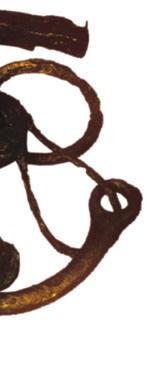
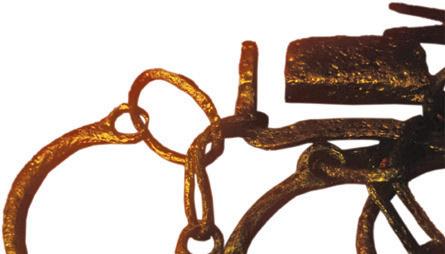
“Melissa est docta,” inquit vēnālīcius. “Melissa linguam Latīnam discit. Melissa cēnam optimam coquit.”
“sed Metella coquum habet,” inquit argentārius. “Metella ōrnātrīcem cupit.”
“Melissa est ōrnātrīx optima,” inquit Syphāx. “Melissa crīnem compōnit. Melissa stolam compōnit. Melissa …”
“satis! satis!” clāmat Caecilius. Caecilius Melissam emit et ad vīllam revenit. Caecilius Metellam vocat. Metella ancillam intentē spectat et Caecilium laudat.
Melissa vīllam circumspectat. Melissa est anxia.
ōrnātrīx hairdresser, stylist portum harbor prope nāvem near a ship anxia worried quaerit is looking for
docta skilled
linguam Latīnam discit is learning the Latin language habet has cupit wants
crīnem compōnit arranges hair stolam dress satis! enough!
1 Remember the difference between the nominative case and accusative case of the following nouns:
nominative Metella Caecilius mercātor accusative Metellam Caecilium mercātōrem
nominative case and accusative case: page 25
2 A large number of words, such as fīlia and taberna , form their accusative case in the same way as Metella . They are known as the first declension and look like this:
nominative Metella fīlia taberna
accusative Metellam fīliam tabernam
3 Another large group of nouns is known as the sec ond declension . Most of these words form their accusative in the same way as Caecilius . For example:
nominative Caecilius amīcus cibus accusative Caecilium amīcum cibum
4 You have also met several nouns belonging t o the third declension . For example:
nominative mercātor leō senex accusative mercātōrem leōnem senem
The nominative ending of the third declension may take various forms, but the accusative nearly always ends in -em.
Pompeian householders loved to have their walls painted with pictures of gardens full of flowers and birds, like this golden oriole.
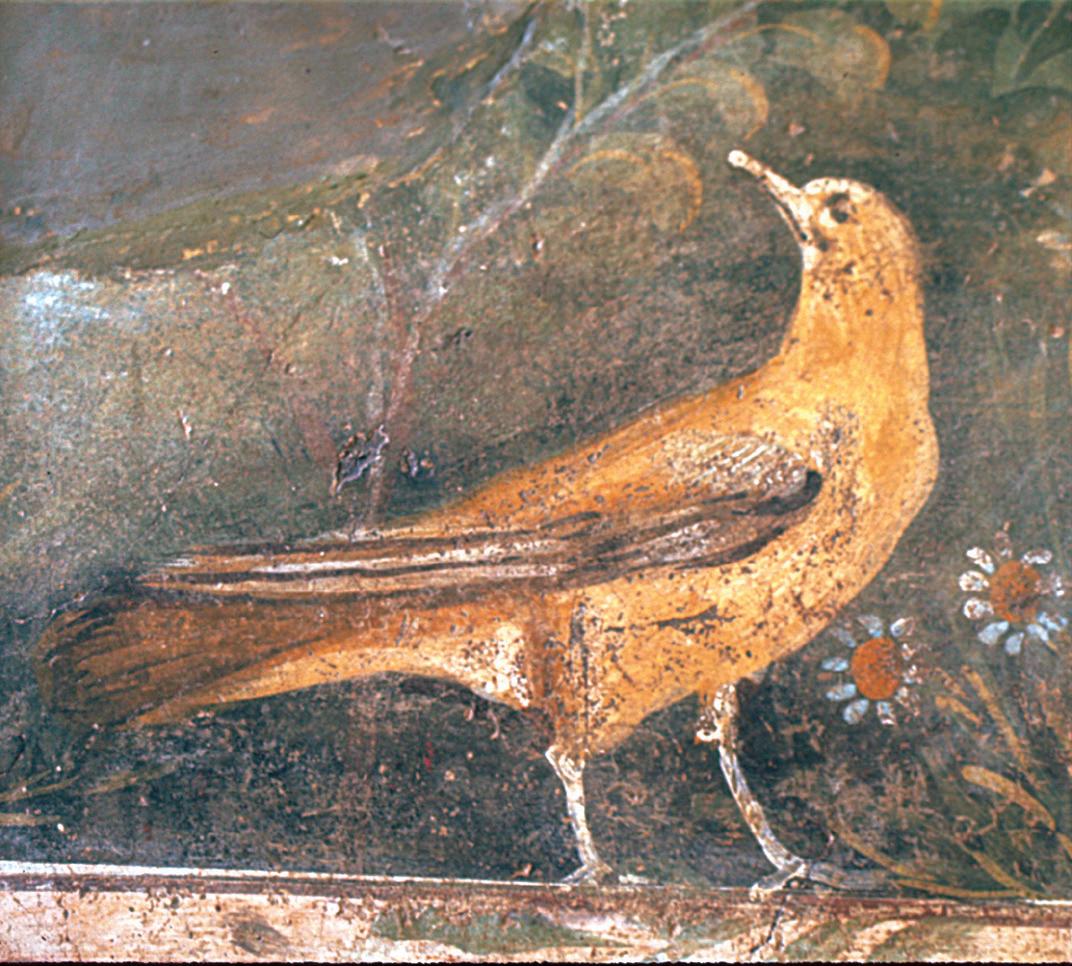
Grumio interrupts a story about Hercules.
Lūcia est in hortō. Lūcia fābulam recitat.
Metella in hortō sedet et fīliam audit. Melissa in hortō labōrat. Melissa quoque Lūciam audit. Cerberus hortum intrat et circumspectat. ecce! canis ad culīnam ambulat.
“Herculēs ad Orcum venit,” inquit Lūcia. “magnus canis iānuam in Orcō custōdit. Herculēs magnum canem capit. canis ferōciter lātrat.”
subitō Grumiō hortum intrat. Grumiō Cerberum ē culīnā dūcit. canis lātrat. coquus nōn est laetus. Lūcia Grumiōnem spectat. “Herculēs est in hortō!” clāmat Lūcia. Metella fīliam laudat. Melissa rīdet.
1 Explore the story
a Line 1: where is Lucia and what is she doing?
b Lines 2–3: what two things is Melissa doing in the garden?
fābulam story Orcum the underworld
is guarding capit catches, captures
c Lines 3–4: what two things does Cerberus do after he enters the gar den?
d Lines 5–7: which one of the following stat ements is true?
A A guard dog in the underworld captures Her cules.
B Hercules captures a guard dog in the underw orld.
e Lines 8–9: where is Grumio leading Cerberus from?
f Line 9: how does Grumio feel?
g Lines 10–11: what does Lucia shout?
2 Explore the language
a Find one Latin word from the st ory that is in the accusative case
b Now identify the declension of your w ord.
c Find two more accusatives from the story, one from each of the two remaining declensions
3 Explore further
accusative case: page 25
declension: page 41
Think about the whole story and then re-read lines 10–11. Why do you think Metella praises Lucia at the end of the story?
I knew nothing about Pompeii before I arrived here on Syphax’s ship, and I was very worried about what kind of place it might be. The rst thing I noticed was how incredibly busy the harbor was. There seemed to be merchants and ships from all over the world. I asked another of the enslaved women if she knew anything about Pompeii; luckily, she had grown up nearby and was happy to tell me about it.


Pompeii is at the crossroads of important coastal trade routes and the inland route along the river to towns like Nuceria. The surrounding area, Campania, has very fertile land and good weather, and there are a number of prosperous towns around here. Outside the towns, especially along the coast, there are lots of villas and farming estates owned by wealthy Romans who have come here to enjoy the climate and beautiful countryside. I was scared that I would end up on a farm where the work might be really hard, but it seems that I’ll be staying here in the city. I hope my work won’t be too dif cult or dangerous.
Pompeii covered 66 hectares (a hectare is 10,000 m2 or twoand-a-half times the size of a soccer field) or 163 acres and was surrounded by a wall. The wall had twelve towers and, it is believed, eight gates. Only seven of these are confirmed, however; the eighth (“Capua Gate”) is assumed to exist, but is in an area that has not yet been excavated. Roads led out from these gates to the harbor and to the neighboring towns of Herculaneum, Nola, Nuceria, and Stabiae.
Thinking point 1: Why do you think the town was surrounded by a wall and towers?


Two wide main streets, known nowadays as the Via dell’Abbondanza (Street of Abundance) and Via Stabiana (Stabiae Street), crossed near the town center. A third ran parallel to the Via dell’Abbondanza. These names are modern inventions to make it easier to identify the streets; we don’t know what, if anything, the Pompeians called them. Sometimes people used local landmarks to help with directions; for example, the delivery address on a wine jar found at Pompeii reads “To Euxinus, the innkeeper, at Pompeii, near the Amphitheater.”
It’s going to take me a while to nd my way around Pompeii. I’m very scared of getting lost; I am going to have to ask for directions a lot. The streets have high sidewalks on one or both sides of the road so you can avoid the traf c of wagons, horses, and mules when you are walking. It also means you can keep clear of the trash, dung, rainwater, and the over ow from the fountains in the roadway. When you need to cross the road, you can use the stepping-stones to avoid getting your feet wet or dirty.




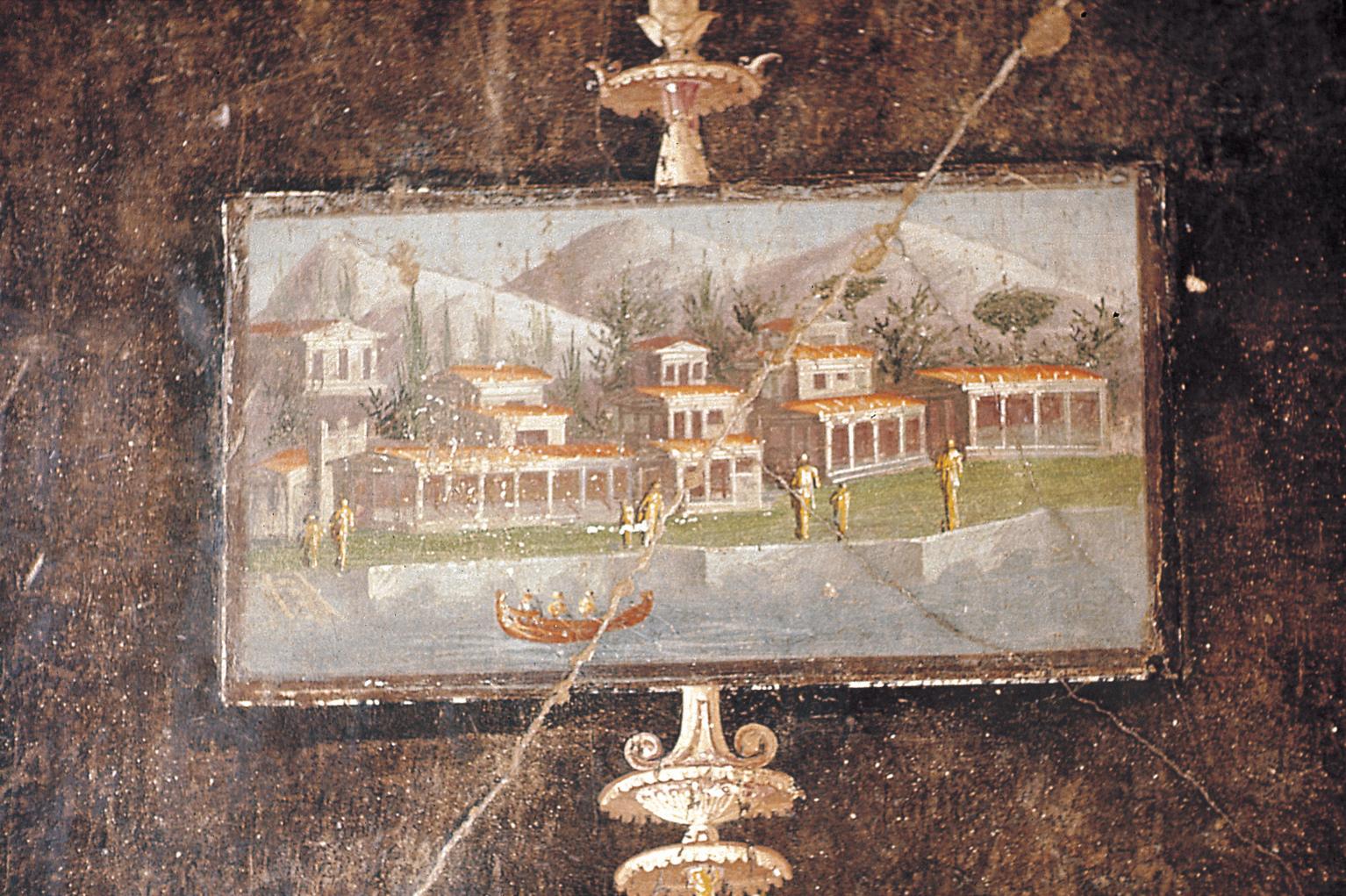
Thinking point 2: Look at this picture of a Pompeian street. Describe what you can see. What do historians claim was the purpose of the raised pieces of stone? What do you think made the ruts you can see running between them?

The buildings around the forum are usually identified as follows: 1 Temple of Jupiter; 2 Market; 3 Temples of the Emperors and the Lares of Pompeii; 4 Eumachia’s building; 5 Open hall; 6 Possible government offices; 7 Basilica; 8 Temple of Apollo; 9 Vegetable market and public lavatory. More details on the buildings and their excavation can be found in Stage 4.
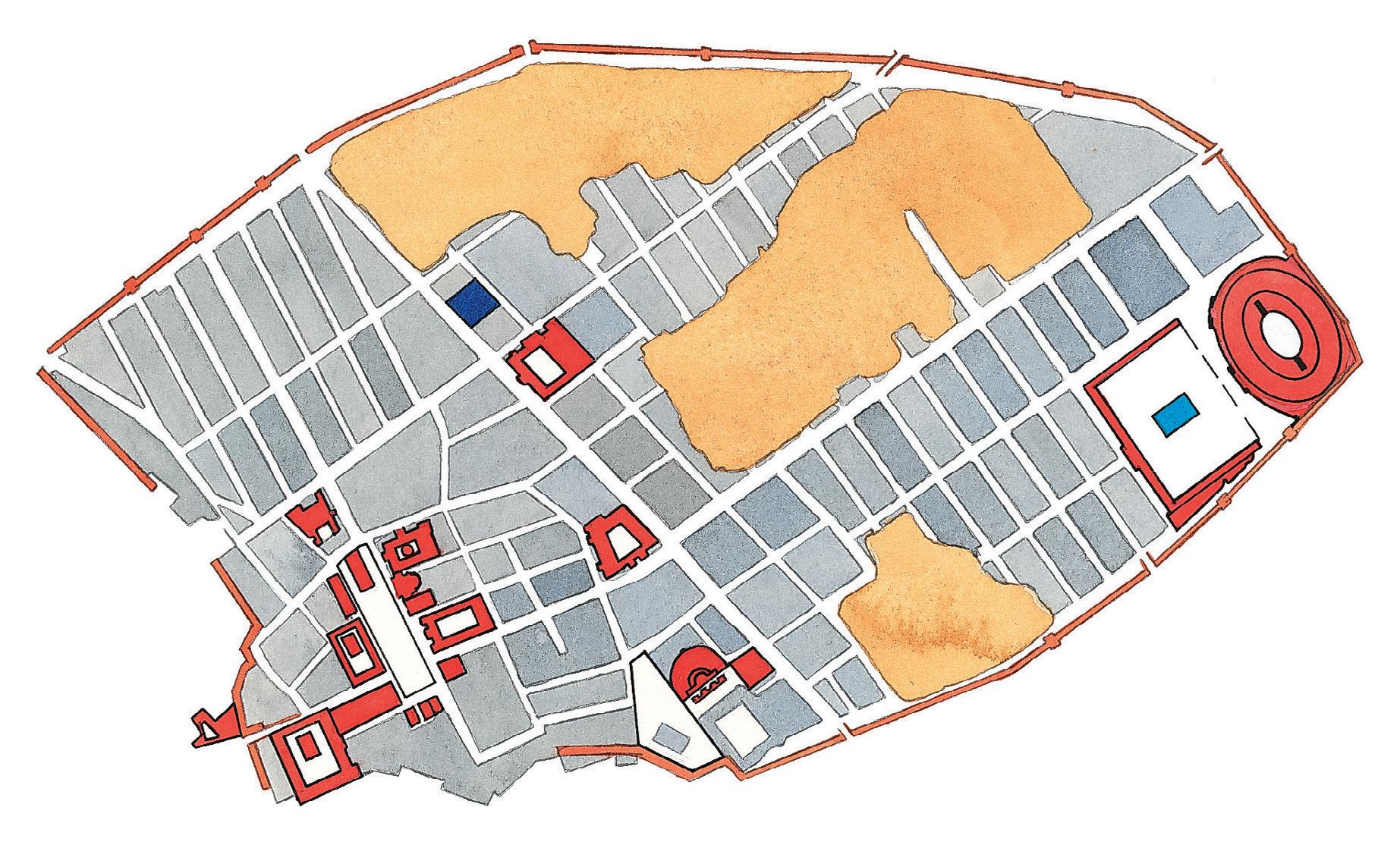
The town’s water supply was brought by an aqueduct from a spring 26 miles (42 kilometers) away. It was distributed via lead pipes which ran beneath the sidewalks to 14 water towers. These water towers were usually built near crossroads, such as the one in the picture below. Water was forced up into lead tanks
Thinking point 3: Caecilius has a delivery arriving on a ship. Find the Sea Gate (that leads to the harbor) on the map. Write out directions to lead the men making the delivery to Caecilius’ house. Remember, there may not have been street names, so you need to use landmarks to help them find their way.

Thinking point 4: Think about a town you know well. Imagine walking down a busy main street and then around a quieter neighborhood. What are the big differences between these experiences? What do you see and hear?


Look at the pictures from Pompeii on the right of this page, which show a main shopping street and a smaller one with more houses. What differences would you expect to see and hear if you were walking along them in ancient Pompeii? How is this different from modern streets?
Crossroads of two main streets – Via dell’ Abbondanza and Via Stabiana – with shops, stepping stones, fountain, and water tower.
Counter with embedded storage jars (dolia), probably for dry goods such as nuts and dried fruits, and wine storage jars (amphorae) in the background.
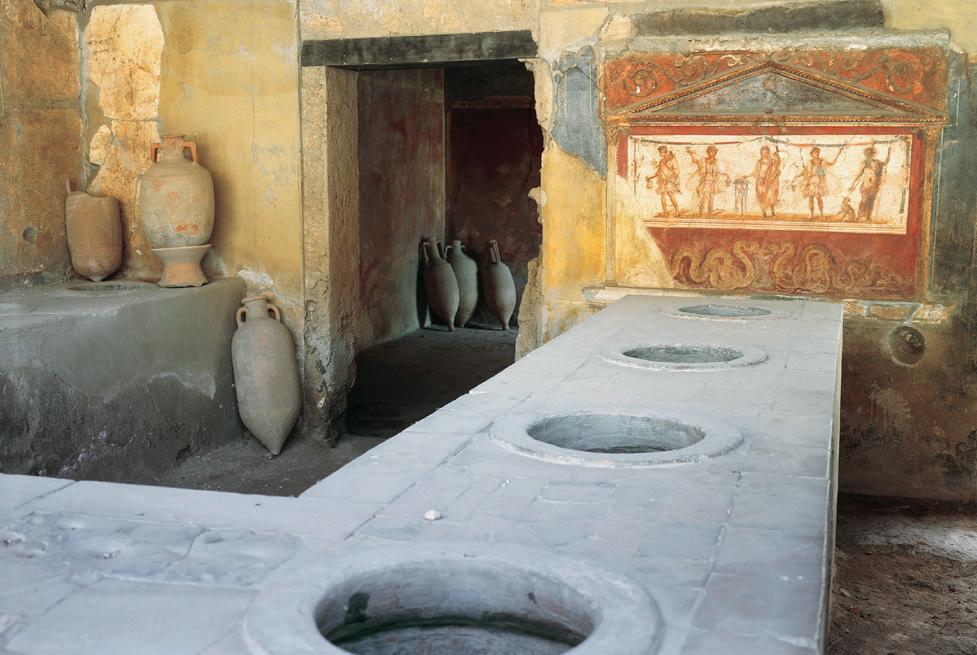
Some bars also have wall paintings that show customers drinking and gambling.

Apparently, the main shopping areas in Pompeii are in the forum and along the street leading to the river-gate. I expect I’ll go there with and for Metella a lot; I’ll have to carry anything she buys and run errands for her.

Carved or painted signs outside the shops and businesses sometimes tell you what they sell and do. I saw one depicting metal workers outside a place I think was a copper or bronze smith. All the main streets also have bakers’ shops and bars where you can buy hot and cold drinks and snacks.
Thinking point 5: Melissa mentions accompanying Metella on shopping trips and running errands for her. What differences do you think there would be between Metella’s and Melissa’s experiences of shopping and moving around Pompeii?


houses in Herculaneum. One has a second story overhanging the sidewalk to provide some extra space.

Plaque often interpreted as a shop sign, although its original location and purpose have been lost.
The forum in Pompeii contained several important religious buildings, but there were many others elsewhere in the town, including the Temple of Venus near the gate to the harbor. The Pompeians had their own unique version of Venus – Venus Pompeiana – who was their patron deity. Each neighborhood also had its own shrines in the streets and each home had its lararium. In this way, religion went from the State to the street to the home.
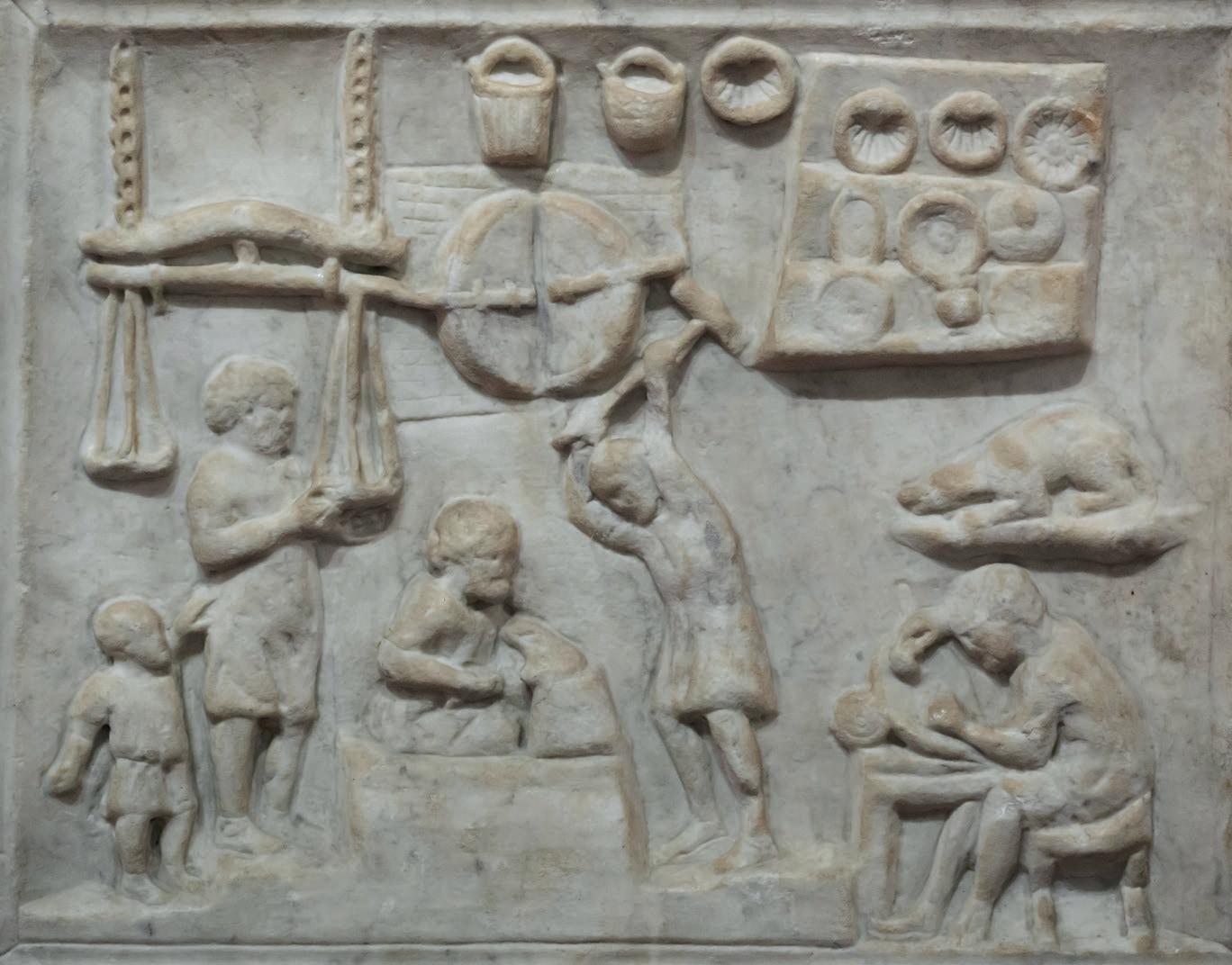
Another shop from Pompeii with a flour or grain mill, which would have been driven by enslaved people or donkeys, and a large, brick oven.
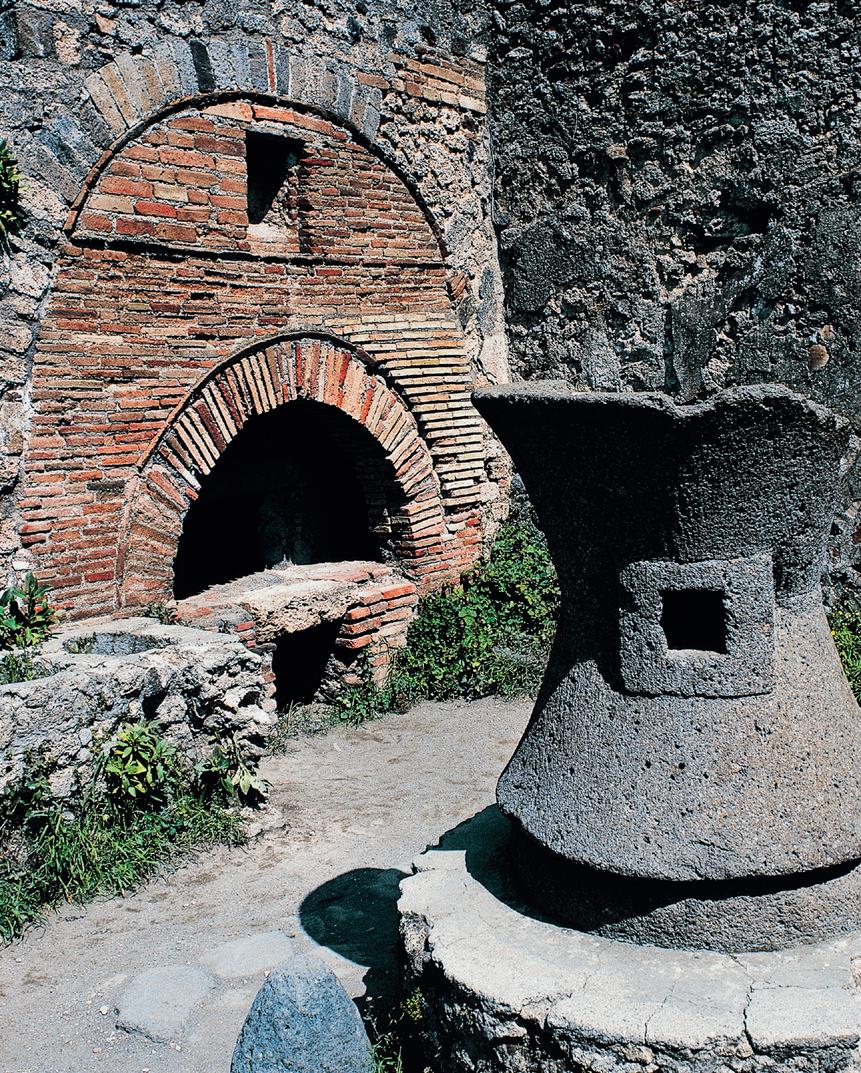
Thinking point 6: Look at the two pictures above. What sort of work may have happened in these buildings? How sure can you be about your claims? Which source is more useful?
Painting of Venus Pompeiana riding in a ship drawn by elephants from the facade of the House of Verecundus on the main street in Pompeii.
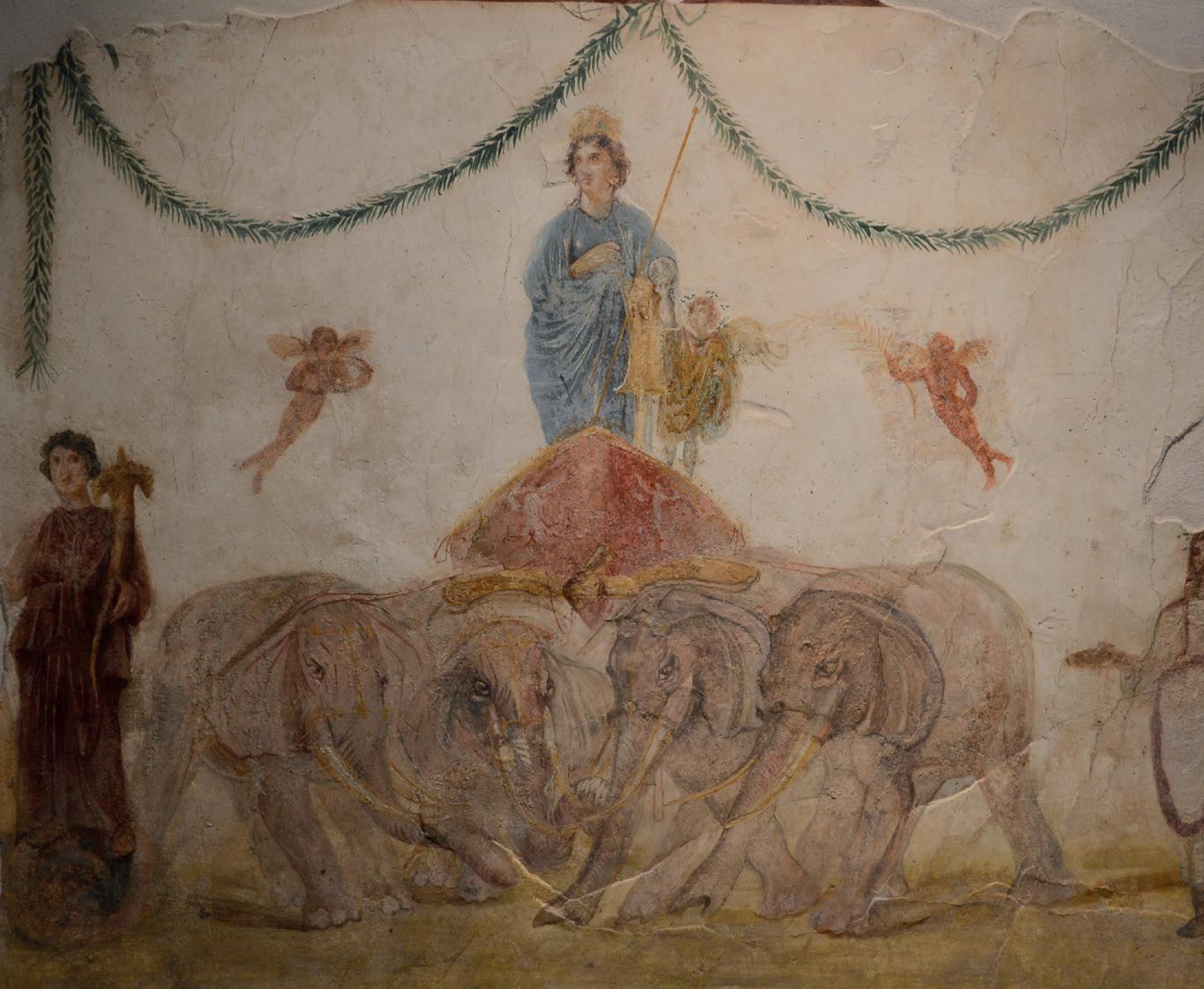
The whitewashed walls outside shops and houses have lots of advertisements and public notices painted on them. My Latin isn’t good, but I can understand some of them. I’ve seen political slogans supporting candidates in the local elections, and advertisements for gladiator ghts and wild-animal hunts in the amphitheater at the eastern end of town.
Pompeii is full of so many different types of people! You hear many different languages as you’re walking around the town, and there are lots of different cultural in uences. As well as people from all over Italy and my fellow Greeks, I’ve met and seen people from all over the Roman Empire, including those from Syria, Africa, and Spain.
A section of wall covered with painted slogans.
Pompeii would have been a thriving, multicultural society. We can see this diversity in the names found in the graffiti, in election campaign notices, in inscriptions on tombs, and even in Caecilius’ own records. Among these are some names that might be Jewish; further evidence of this community includes fish sauce labeled as kosher and one inscription in Hebrew.

The Roman Empire in this period stretched from Britain in the northwest to the region of modern Syria and the area known as Israel or Palestine in the east. The empire was held secure by soldiers stationed at strategic points, and troublemakers were not tolerated. Resistance or rebellion was handled without mercy.


Think about your community; would a future historian be able to use similar methods to learn more about its diversity? How easy or difficult do you think it would be?


Pompeii was well positioned for sea trade and had excellent connections with the wider empire. The network of well-built roads created by the Romans made travel by land relatively easy, but for many purposes, particularly for trade, travel by sea was more convenient. Ships carried cargoes of building materials, food, and luxury goods across the Mediterranean and beyond. Some delicacies, such as pepper, made it as far as the frontier zone in Britain. As we see in this Stage, ships like Syphax’s also carried cargoes of enslaved people like Melissa who might be transported far from home and sold into totally unfamiliar environments where they might not even speak the local language.
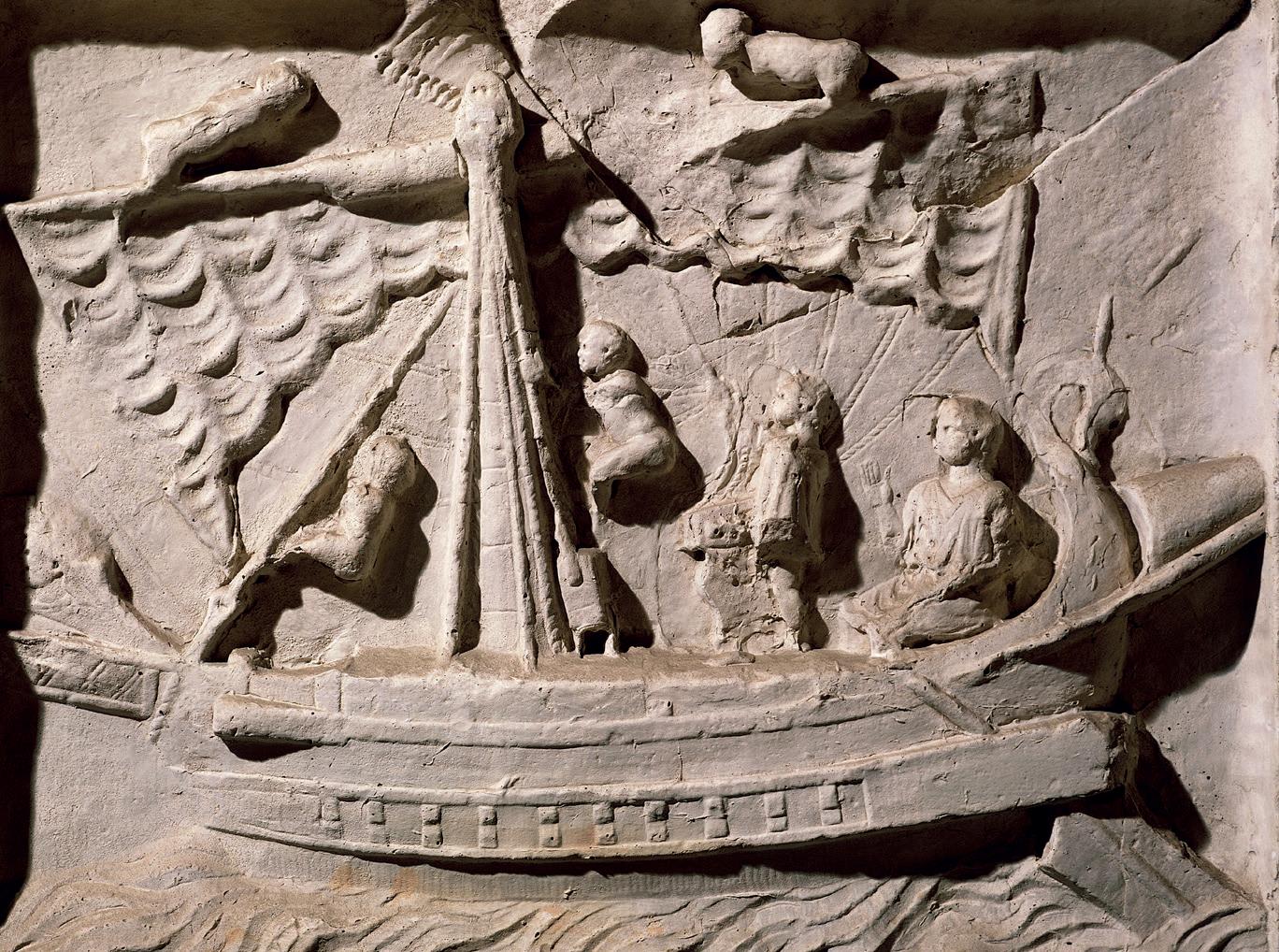
You may wish to consider the following:
• the sights, smells, and sounds you would experience
• the route you might be walking (use the map shown earlier in the Stage)
• the buildings you may pass
• the kind of streets you are on and the features they may have
• who and what else might be in the street
• what you may see on the walls of the buildings
ad to, toward bibit drinks
circumspectat looks around clāmat shouts
et and exit goes out exspectat waits for iānua door
īrātus angry magnus big
nāvis ship
nōn not portat carries respondet replies
rīdet laughs, smiles
salvē! hello!
sedet sits
taberna shop
videt sees
vīnum wine
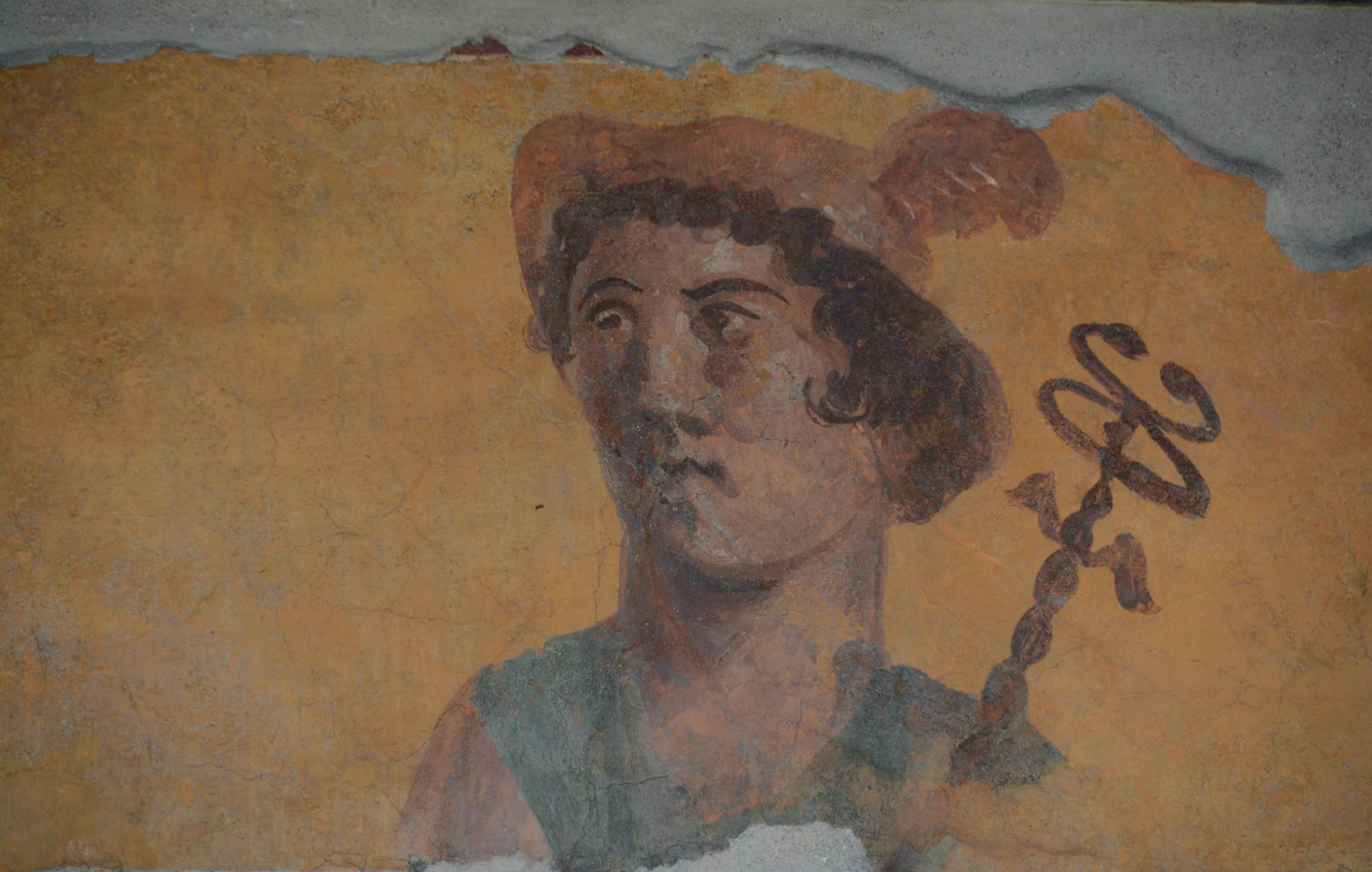
to the business.

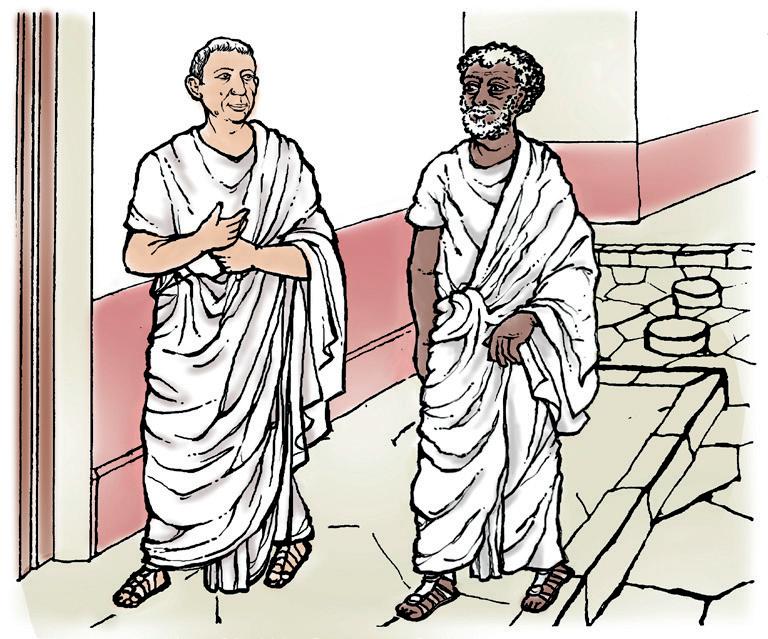
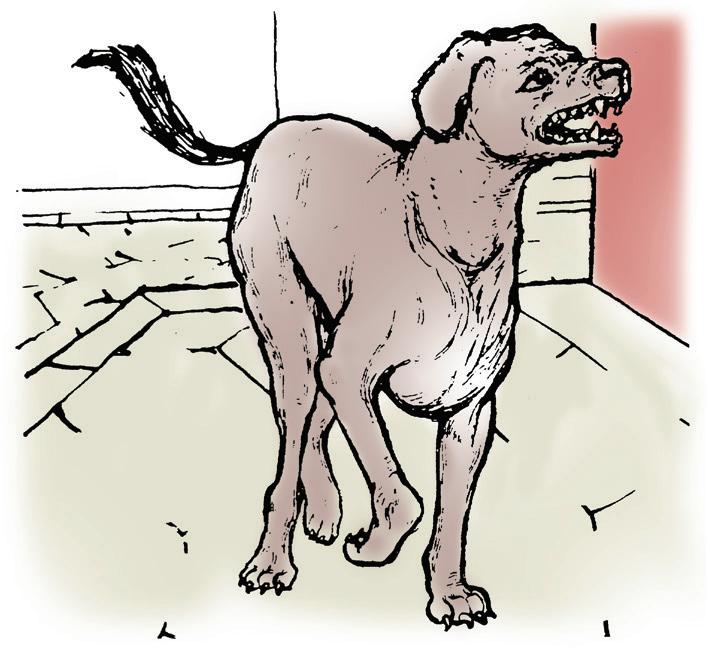

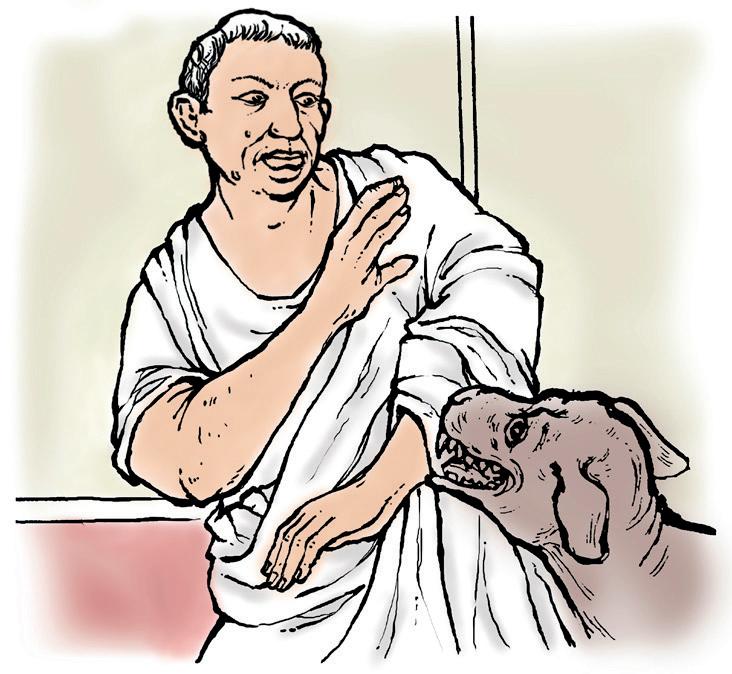
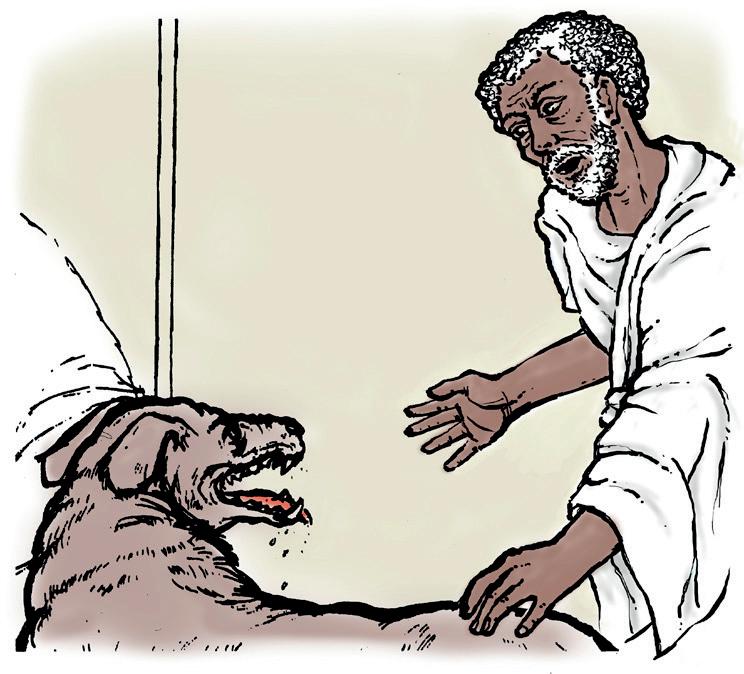
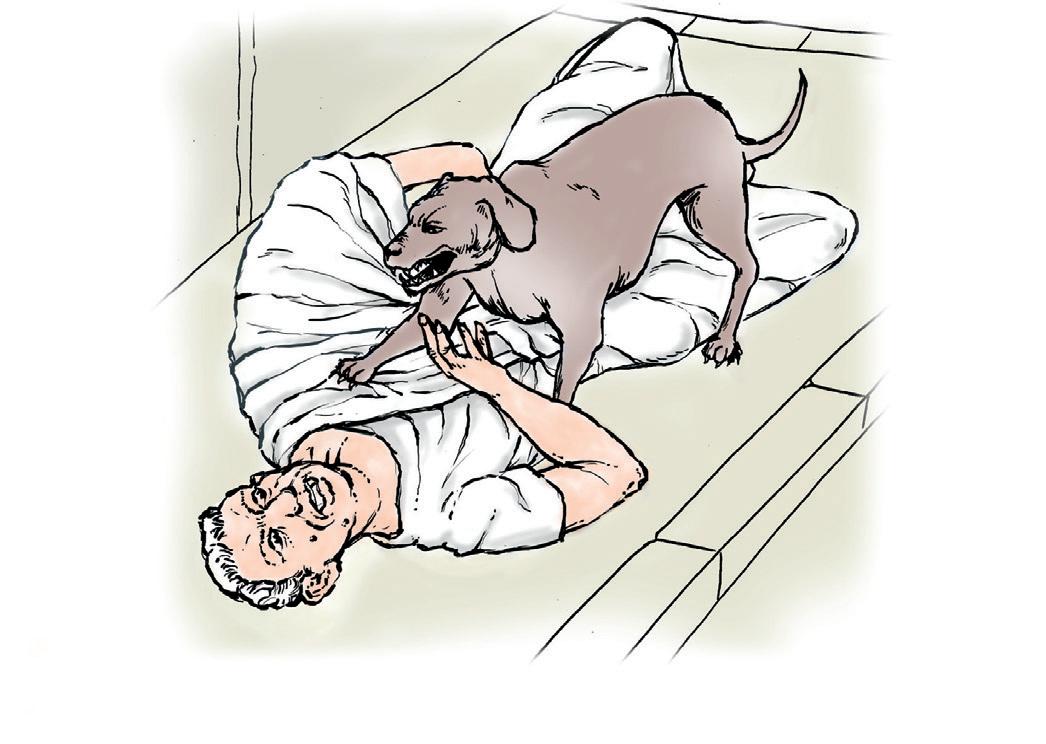
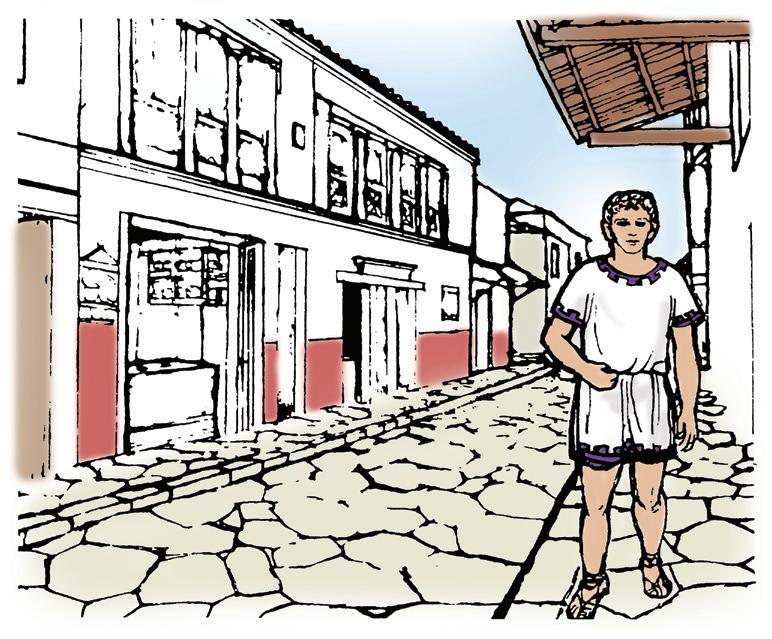
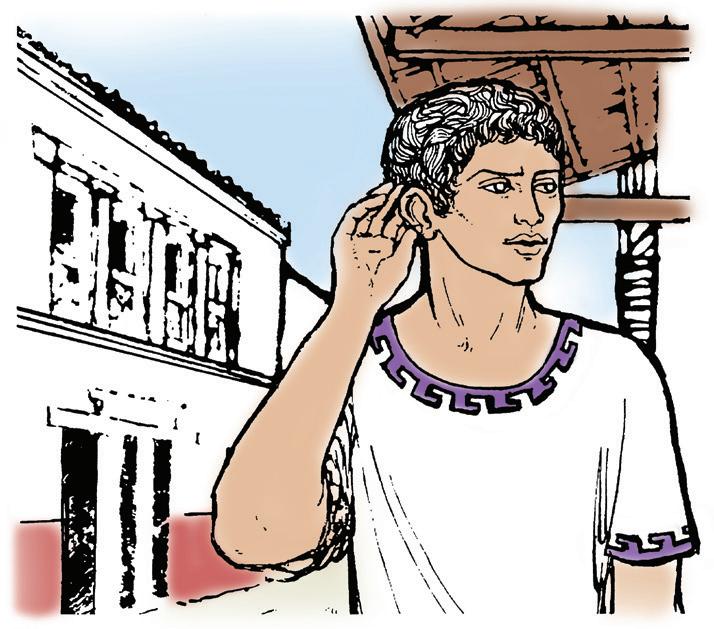
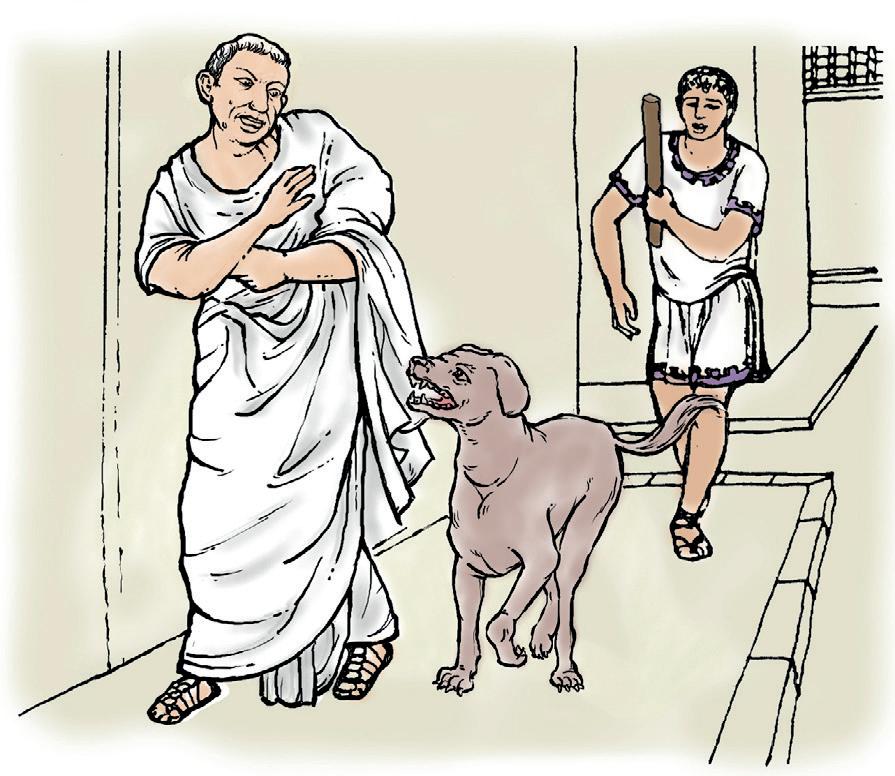

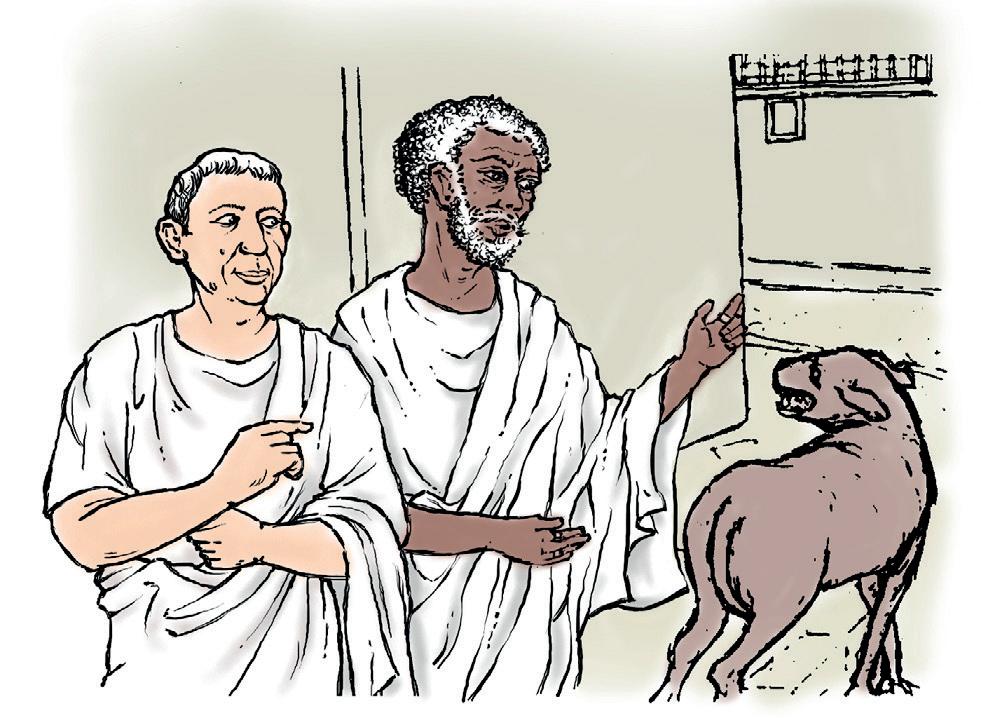
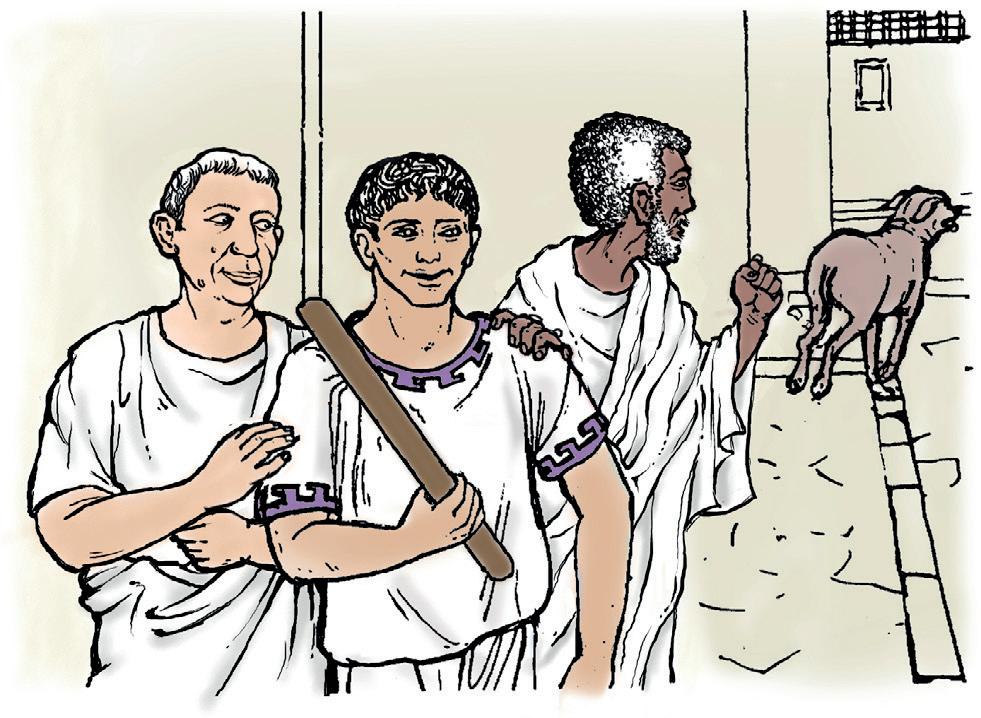
Clēmēns in forō ambulābat. maxima turba erat in forō. servī et ancillae cibum emēbant. multī pistōrēs pānem vēndēbant. poēta recitābat.
mercātor Graecus contentiōnem cum agricolā habēbat. mercātor īrātus pecūniam postulābat. subitō agricola mercātōrem pulsāvit, quod mercātor agricolam vituperābat. Pompēiānī rīdēbant, et agricolam incitābant.
Clēmēns, postquam clāmōrem audīvit, ad pugnam festīnāvit. tandem agricola mercātōrem superāvit et ē forō agitāvit. Pompēiānī agricolam fortem laudāvērunt.
multī Pompēiānī in tabernā vīnum bibēbant. Clēmēns tabernam intrāvit. subitō Clēmēns “Fēlīx!” clāmāvit.
Clēmēns Fēlīcem laetē salūtāvit. Fēlīx erat lībertus.
Clēmēns Fēlīcem ad vīllam invītāvit. Clēmēns et Fēlīx vīllam intrāvērunt. Lūcia in ātriō stābat. Fēlīx Lūciam salūtāvit. Clēmēns Caecilium et Metellam quaesīvit. Caecilius in hortō legēbat. Metella in tablīnō scrībēbat. Caecilius et Metella ad ātrium festīnāvērunt et Fēlīcem salūtāvērunt.
postquam Quīntus ātrium intrāvit, Fēlīx iuvenem spectāvit. lībertus erat valdē commōtus. paene lacrimābat, sed rīdēbat. tum Clēmēns ad culīnam festīnāvit. Grumiō in culīnā dormiēbat. Clēmēns coquum excitāvit et tōtam rem nārrāvit. coquus, quod erat laetus, cēnam optimam parāvit.

pugna fight
maxima very large erat was pistōrēs bakers pānem vēndēbant were selling bread contentiōnem habēbat was having an argument cum agricolā with a farmer postulābat was demanding pulsāvit hit, punched quod because incitābant were urging on postquam when, after festīnāvit hurried superāvit overpowered agitāvit chased
5
in tabernā in an inn laetē happily lībertus freedman, formerly enslaved man invītāvit invited valdē commōtus very moved, very shaken paene lacrimābat was almost crying tum then excitāvit woke up tōtam rem nārrāvit told the whole story parāvit prepared
post cēnam Lūcia rogāvit, “pater, cūr Fēlīx nunc est lībertus? ōlim erat servus tuus.” tum pater tōtam rem nārrāvit.
Caecilius: Fēlīx ōlim in tablīnō scrībēbat. Fēlīx erat sōlus. Clēmēns et Grumiō cibum in forō quaerēbant. Metella aberat, quod sorōrem vīsitābat.
Fēlīx: pater tuus aberat, quod argentāriam in forō administrābat.
Caecilius: nēmō erat in vīllā nisi Fēlīx et īnfāns. parvus īnfāns in cubiculō dormiēbat. subitō fūr per iānuam intrāvit. fūr tacitē ātrium circumspectāvit; tacitē cubiculum intrāvit, ubi īnfāns erat. Fēlīx nihil audīvit, quod intentē labōrābat. fūr parvum īnfantem ē vīllā tacitē portābat. subitō īnfāns vāgīvit. Fēlīx, postquam clāmōrem audīvit, statim ē tablīnō festīnāvit.
“furcifer!” clāmāvit Fēlīx īrātus, et fūrem ferōciter pulsāvit. Fēlīx fūrem paene necāvit. ita Fēlīx parvum īnfantem servāvit.
Fēlīx: dominus, postquam rem audīvit, erat laetus et mē līberāvit. ego igitur sum lībertus.
Lūcia: sed quis erat īnfāns?
Caecilius: erat Quīntus!

fūr thief
post after rogāvit asked nunc now
ōlim once, some time ago sōlus alone aberat was out sorōrem sister administrābat was managing nisi except īnfāns child, baby parvus little tacitē quietly, silently ubi where nihil nothing portābat began to carry vāgīvit wailed statim at once necāvit killed ita in this way servāvit saved līberāvit freed, set free igitur therefore
1 All the stories in the first five Stages were written as if happening in the present, and in every sentence the v erbs were in the present tense . Study the following examples:
PRESENT TENSE
singular amīcus labōrat The friend works or The friend is working.
plural amīcī labōrant . The friends work or The friends are working.
2 In Stage 6, because the stories happened in the past, y ou have met the imperfect tense and the perfect tense . Study the different endings of the two past tenses and their English translation:
IMPERFECT TENSE
singular poēta recitābat A poet was reciting. Metella in hortō sedēbat . Metella was sitting in the garden.
plural amīcī in forō ambulābant The friends were walking in the forum.
Pompēiānī vīnum bibēbant . The Pompeians were drinking wine.
PERFECT TENSE
singular puella intrāvit . The girl entered.
Clēmēns clāmōrem audīvit Clemens heard the noise.
plural amīcī Caecilium salūtāvērunt . The friends greeted Caecilius.
iuvenēs ad tabernam festīnāvērunt The young people hurried to an inn.
3 Compare the endings of the imperfect and perfect t enses with the endings of the present tense.
singular plural
PRESENT portat portant
IMPERFECT portābat portābant
PERFECT portāvit portāvērunt
You can see that in the imperfect and perfect t enses, as with the present tense, the singular ends in -t and the plural in -nt .
4 Notice how Latin shows the diff erence between “is,” “are,” and “was,” “were.”
singular plural
PRESENT Lūcia est in tablīnō. fēminae sunt in hortō.
Lucia is in the study. The women are in the garden.
IMPERFECT Lūcia erat in forō. fēminae erant in viā.
Lucia was in the forum. The women were in the street.
5 In the following examples, you will see that the imperfect tense is often used for an action or situation which was going on for some time.
īnfāns in cubiculō dormiēbat . pater et māter aberant .
The baby was sleeping in the bedroom. The father and mother were awa y.
6 The perfect tense, on the other hand, is oft en used for a completed action or an action that happened once.
agricola mercātōrem pulsāvit
The farmer punched the merchant.
Pompēiānī agricolam laudāvērunt .
The Pompeians praised the farmer.
This richly decorated room full of mythological frescoes is from the House of the Vettii in Pompeii. The Vettii brothers were freedmen who became rich through trade, and their house is one of the most lavish found in Pompeii.

Two thieves pick an easy target: or so they think! duo fūrēs ōlim ad vīllam contendēbant. in vīllā mercātor habitābat. mercātor erat senex et avārus. avārus multam pecūniam habēbat. fūrēs, postquam vīllam intrāvērunt, ātrium circumspectāvērunt.
“avārus,” inquit fūr, “est sōlus. avārus servum nōn habet.”
tum fūrēs tablīnum intrāvērunt. avārus clāmāvit et ferōciter pugnāvit, sed fūrēs senem facile superāvērunt.
“ubi est pecūnia, senex?” rogāvit fūr.
“servus fidēlis pecūniam in cubiculō custōdit,” inquit senex.
“tū servum fidēlem nōn habēs, quod avārus es,” clāmāvit fūr. tum fūrēs cubiculum petīvērunt.
“pecūniam videō,” inquit fūr. fūrēs cubiculum intrāvērunt, ubi pecūnia erat, et pecūniam intentē spectāvērunt. sed ēheu! ingēns serpēns in pecūniā iacēbat. fūrēs serpentem timēbant et ē vīllā celeriter festīnāvērunt.
in vīllā avārus rīdēbat et serpentem laudābat.
“tū es optimus servus. numquam dormīs. pecūniam meam semper servās.”
duo two habitābat was living
inquit said
pugnāvit fought facile easily fidēlis faithful
ingēns serpēns huge snake iacēbat was lying timēbant were afraid of, feared celeriter quickly numquam never servās you look after, you keep safe
a Lines 1–2: who was hurrying to a merchant’s house?
b Lines 2–3: what three things are we told about the merchant ?
c Lines 3–4: what did the thieves do after entering the house?
d Lines 5–6: why did one of the thieves think the miser would be alone?
e Lines 7–8: which two Latin words show the miser put up a fier ce resistance to the thieves?
f Line 10: who did the old man say was guarding his money?
g Lines 13–15: where did the thieves find the money?
h Lines 15–16: what was lying on the money?
i Lines 16–17: why did the thieves leave the house in a hurry?
j Lines 19–20: what three things did the miser say in praise of the snake?
2 Explore the language
Look at these sentences from the st ory:
tum fūrēs tablīnum intrāvērunt. (line 7)
ingēns serpēns in pecūniā iacēbat. (lines 15–16)
The verbs in these sentences are in different tenses
imperfect tense and perfect tense: page 88
Explain how the different tenses change the meaning of each v erb. You might want to use the words imperfect and perfect to refer to the tenses.
3 Explore further
Think about the whole story.
a What qualities of the snake did the old man praise?
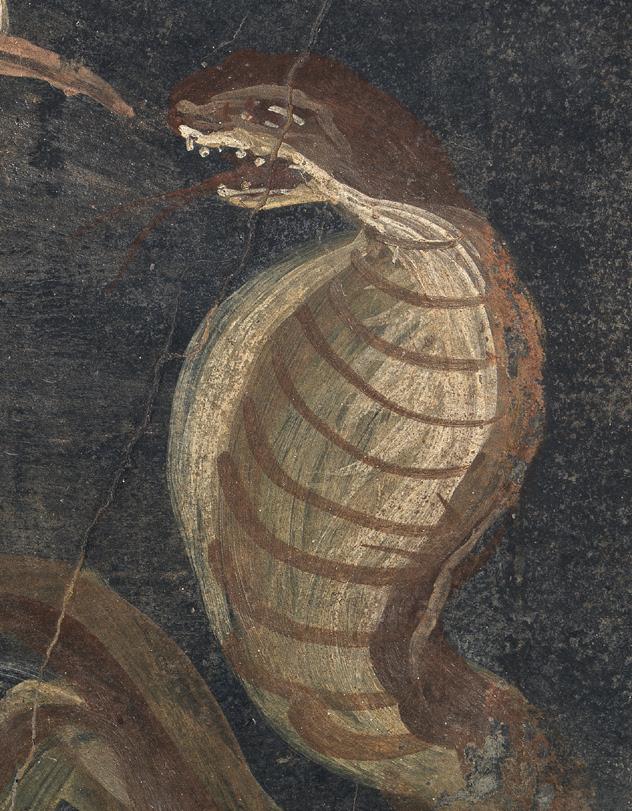
b The old man called the snake an optimus servus . Does this s tory and the attitude of the old man fit with what you have learned about Roman attitudes toward enslavement?
ingēns serpēns.
Reviewing the language Stage 6: page 227

Wherever you traveled in the Roman world, you would find people who had been enslaved, like Grumio, Clemens, and Melissa. While some people seem to have been concerned about the morality of enslavement, no serious attempt was made to abolish it. In this section, we imagine how Melissa, Grumio, and Felix might explain enslavement and freedom. In reality, however, we have very little evidence which tells us what enslaved people thought or felt about their lives, and the horror of enslavement is impossible to understand for those who have never experienced it.
Since he bought me from Syphax, I am now considered to be the property of Caecilius. I have no choice in who owns me; I can be sold or given away as Caecilius wishes. Even my name can be changed if he chooses. I cannot marry or own personal possessions, and I can’t seek the protection of the law courts.
The law did not even regard people like Melissa as human beings. Instead, they were treated as property to be bought and sold.
Thinking point 2: The vocabulary at the back of this book gives two translations for servus (male slave and enslaved man) and ancilla (female slave and enslaved woman). The difference between these translations is important. The word “slave” defines what a person like Melissa is, whereas “enslaved” describes what has been done to them
How might the choice of “slave” or “enslaved” change how we think about people like Melissa, Grumio, and Clemens? What attitudes toward them might each choice reflect?
By the beginning of the first century AD, there were perhaps as many as three enslaved people for every five free people in Italy. The Romans enslaved people of all races and cultures from all over the world: Gaul and Britain, Spain and North Africa, Egypt, different parts
Thinking point 1: What do we mean when we say someone is “enslaved”? Does enslavement still exist today?



of Greece and Asia Minor, Syria, and the rest of west Asia. The Romans often enslaved people who were taken as prisoners in war or captured by pirates. Families would be split up and people given new names. Children born to enslaved parents were automatically enslaved and could be bought and sold, regardless of their parents’ wishes.
Captured and enslaved men, women, and children would be paraded as part of a victory procession (“triumph”) through the streets of Rome. Images of bound captives destined for enslavement beneath a Roman trophy are common in art celebrating the military victories of the emperors. This example from the Temple of Apollo Sosianus in Rome shows a man and a woman, bound and seated on a platform ready to be lifted up and carried in a triumphal procession.
Thinking point 3: Describe how the captives are depicted in this relief. What does this source tell you about the Roman attitudes to such people?
Some enslaved people were owned privately by a dominus like Caecilius. Others were owned publicly: by the town council, for example. Those Roman families who could afford it owned at least one or two enslaved people. A merchant like Caecilius would have had no fewer than a dozen in his house and many more working on his estates and in his businesses. Very wealthy households kept hundreds, sometimes even thousands, of people in enslavement. A man called Pedanius Secundus had 400 enslaved people in his house in Rome; when one of them murdered him, they were all put to death, despite the protests of the people of Rome.

In the country, enslaved people were made to work as shepherds and ranchers on big estates, laborers on farms, miners, and builders of roads and bridges. Some of the strongest were bought for training as gladiators. In cities, enslaved people were used for a variety of skilled and unskilled work, including as cooks, gardeners, craftsmen and -women, secretaries, musicians, actors, and entertainers. Often free and enslaved people worked side by side, although a free person could choose to leave and earned a personal living from their work.
As shown in these pictures, enslaved people had to do a wide variety of work, from serving drinks in the home and nursing children to heavy labor, such as transporting goods.

Thinking point 4: Think back over the previous Stages. What tasks have you seen being done by enslaved people?
Working in a household like Caecilius’ is not as hard or dangerous as being down a mine or on a farm, but that doesn’t mean it is easy. Metella, as our domina, keeps a close eye on the quality of my work, and if she doesn’t like my cooking she can have me punished. A dominus or domina is free to beat those they enslave, and one common punishment is to be sent away to do much harder, more dangerous work on a farm or estate. I really don’t want that!
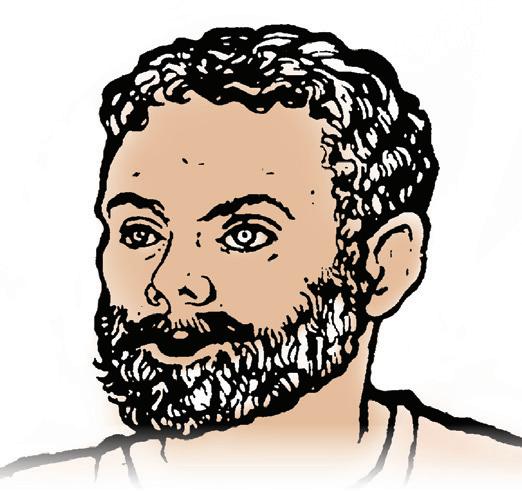
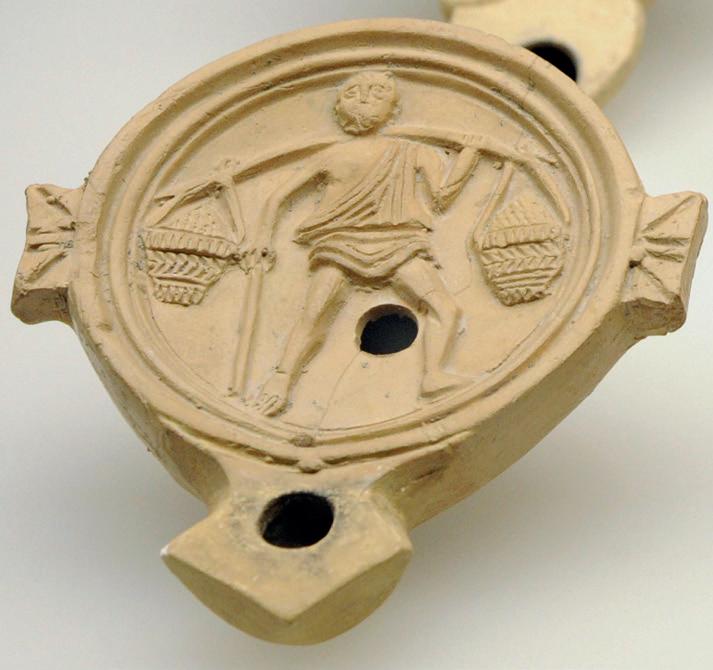
I am free to move about the streets of the town. In fact, if someone met me on the street, they might not realize I am enslaved; they might think I am a poor, free man. I can go shopping, visit temples, and attend performances at the theater and amphitheater. The big difference is that I can only do these things with the permission of Caecilius and Metella; I cannot choose how I spend my days.

Many enslaved people would have faced cruel and violent treatment in addition to the trauma of being enslaved. Roman law stated that someone had to have a “good reason” to actually kill a person they held in enslavement, but in reality this provided little or no real protection for the enslaved. Enslaved people were considered to be the property of their dominus or domina, who controlled many aspects of their life, including access to necessities such as food, shelter, or clothing. A dominus or domina might pay a large sum of money for a highly skilled enslaved person: for example, someone who could read and write, keep accounts, or manage the work of a small shop. Therefore, although they might try to keep enslaved people fit and healthy, they probably viewed them more as investments than as fellow human beings.
This mosaic from the Villa Romana del Casale in Sicily shows an enslaved man being beaten.
The Roman author Seneca records that a law was proposed requiring enslaved people to wear distinctive clothing so that they could be easily recognized. The lawmakers, however, realized that this meant that enslaved people might recognize each other, understand the strength of their numbers, and rebel against those who held them in enslavement. The idea was abandoned.

Enslaved people may have been treated like property, but they did not simply obey unthinkingly. Acts of resistance might include completing tasks slowly or poorly, but there were also full-scale rebellions. In 73–71 BC, the gladiator Spartacus famously led thousands of enslaved people in an armed uprising, which at one point threatened Rome itself.
Enslaved people also frequently tried to escape. The Romans called such people “fugitives” (fugitīvī from the verb fugit, meaning “flees”), a word we still use today. Harboring fugitives was a crime. Detailed descriptions of fugitives were put up in public places and rewards offered for their capture. Some people hired professional slave-hunters. A captured fugitive might have a brand or tattoo put on their face so everyone knew they had tried to escape.
Thinking point 5: The word “fugitive” reflects how the Romans thought about people who tried to escape from enslavement: they had broken the law and were criminals. Would such people have thought of themselves as “fugitives”? Can you think of an alternative term to use when referring to them?
In a letter to his friend P. Rufus, the Roman politician Cicero appealed for his help locating an enslaved man who had escaped:
“Dionysius, an enslaved man of mine who looked after my library (and is worth a large sum of money), stole a large number of books and ran away to escape punishment. He is in your province. My friend Marcus Bolanus and many others saw him at Narona, but they believed him when he said I had given him his freedom. If you would take the trouble to return this man to me, I can’t tell you how grateful I would be.”
(Ad. Fam. 13.77.3)
P.Rufus was the governor in charge of the area (“province”) in which Cicero suspected Dionysius was hiding. Despite Cicero’s political connections, however, Dionysius appears to have evaded capture.
Thinking point 6: What may have been the challenges for a person like Dionysius trying to escape from enslavement?




The act of freeing an enslaved person was called manūmissiō (manumission). This word is connected with two other words, manus (hand) and mittō (send), and means “a sending out from the hand” or “setting free from control.” Manumission was performed in several ways. The oldest method took the form of a legal ceremony before a public official, such as a judge. This is the ceremony seen in the picture at the beginning of this Stage. A witness claimed that the enslaved person did not really belong to their dominus or domina, who did not deny this; then the enslaved person’s head was touched with a rod and they were declared officially free. There were also other, simpler methods. A dominus or domina might manumit an enslaved person by making a declaration in the presence of friends at home or merely by an invitation to recline on the couch at dinner.


Sometimes, as in my case, freedom is given as a reward for a speci c act or maybe for long service. While the law says they cannot own personal possessions, an enslaved person might amass assets such as money, goods, and land that they can exchange for their freedom, although this is rare. People are also sometimes freed after the death of their dominus or domina by a statement in the will.
Most enslaved people will never be freed, however, and there are laws limiting who can be. For example, an enslaved person cannot be freed before the age of 30, and no more than 100 people (fewer in a small household) can be freed in a single will.
A man who has been freed, like me, is known as a lıībertus (freedman). Freedmen can make their own way in life and might even become important members of the community; Caecilius’ own father was actually a freedman. We do not, however, receive all the privileges of a citizen who was born free. We cannot stand as candidates in public elections or become high-ranking of cers in the army.
Some freedmen continued to do the same work they did when enslaved or were set up in business by those who previously held them in enslavement. Others became priests in the temples or worked for a town council; the council secretaries, messengers, town clerk, and town crier are all thought to have been freedmen. The architect who designed the large theater in Pompeii was a freedman named Marcus Artorius Primus.
Some freedmen became very rich and powerful. The Vettii, two freedmen who were possibly brothers, owned one of the most magnificent houses in Pompeii.
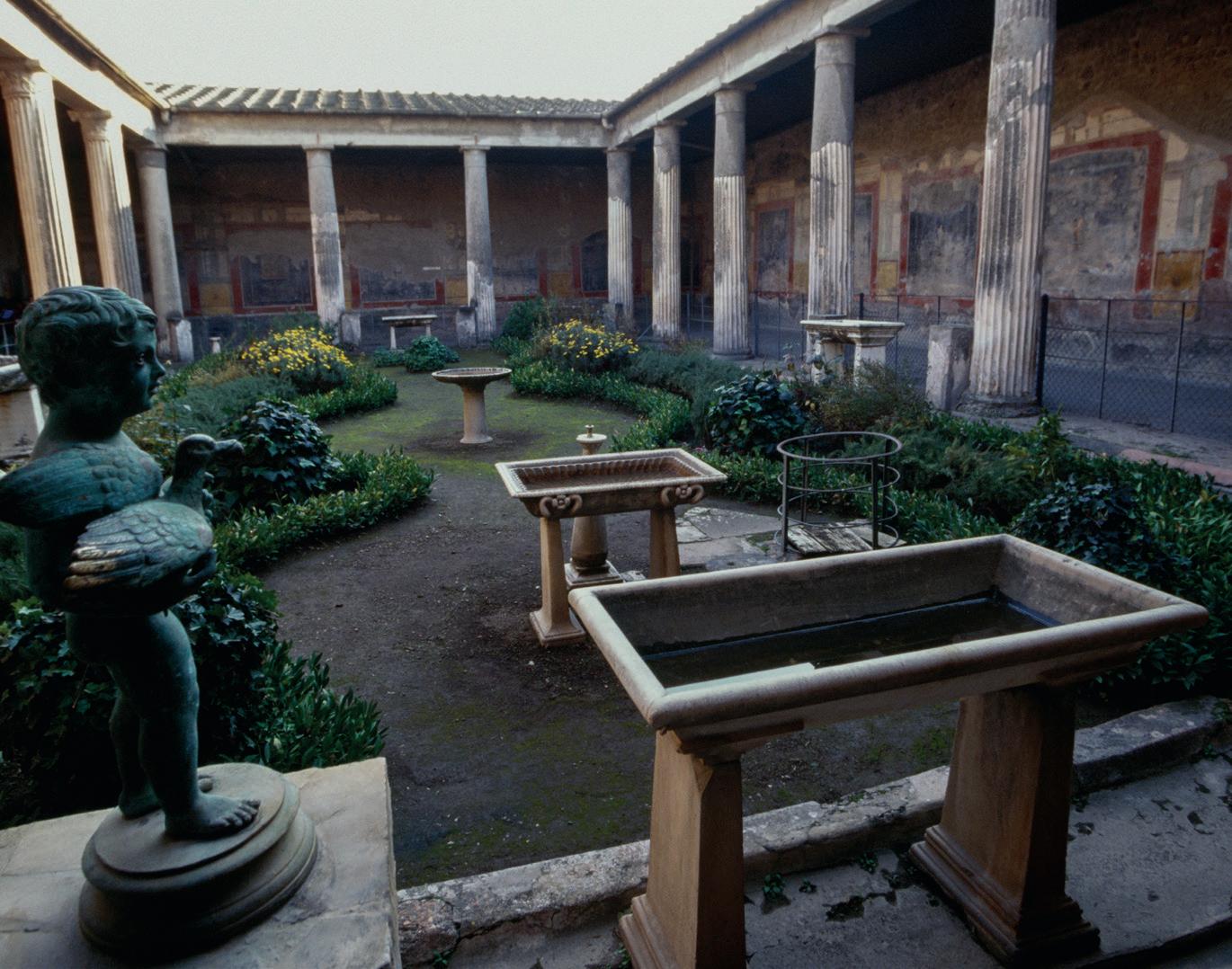
Despite being free, I still have obligations to Caecilius. I have to work for him for a xed number of days each year and am expected to help and support him whenever I can. I am one of his clients and visit him regularly to pay my respects, usually early in the morning for the salutatio. This connection is shown by my name: Caecilius’ full name is Lucius Caecilius Iucundus, so now I am called Lucius Caecilius Felix.
A woman who had been freed from enslavement was called a līberta. Like freedmen, many freedwomen earned their living using the skills they had learned while enslaved. Some stayed in the house where they had been enslaved and may have worked as hairdressers, seamstresses, or nurses. Others are known to have worked as shopkeepers, artisans, and even moneylenders. Some freedwomen married men who had previously held them in enslavement. We can never know the thoughts and feelings of these women, however, and therefore cannot make claims about whether they did so of their own free will.
Thinking point 7: How free were freedmen and freedwomen? What links and obligations did they have to the people who previously held them in enslavement?






Families might contain a mixture of free and enslaved people. We can see an example of one such family in the picture on the right of this page. In this memorial for a baby, the names of the baby’s father and grandparents suggest that the father was a freedman, while the baby’s grandparents were probably enslaved. The inscription reads:
“To the memory of Eucopio, who died aged 6 months and 3 days.
The sweetest, most pleasant, and agreeable infant, even though he was not yet able to speak. Lucius Curio Terminalis, and his parents, Verna and Sosipatra, made this.”
Thinking point 8: Think back to what you learned about Roman names in Stage 1. What about this inscription suggests that Lucius Curio Terminalis was free and that his parents were enslaved? How much do we know about the lives of people enslaved by the Romans?
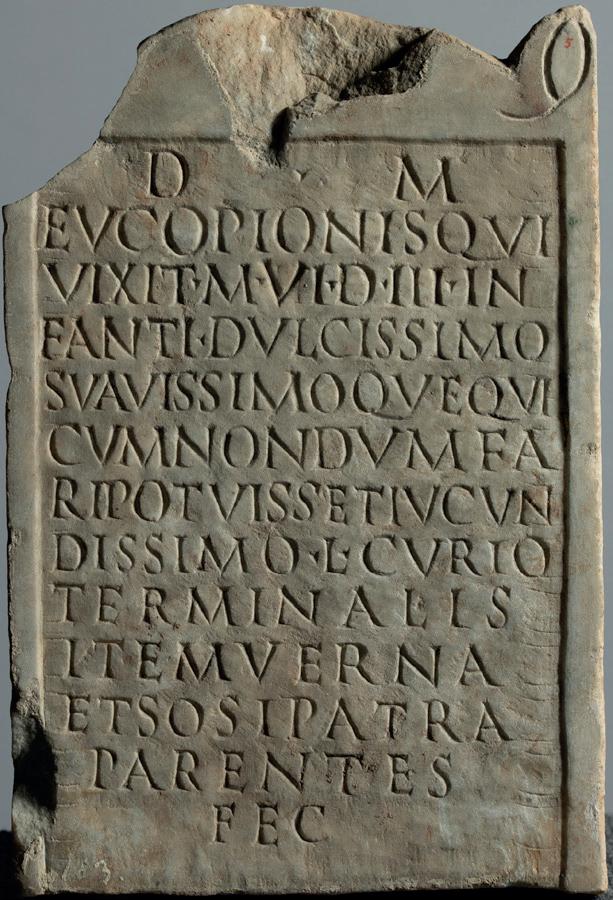
You may wish to consider the following:
• the types of work they did and their treatment
• acts of resistance
• how enslaved people were freed
• how the Romans thought about enslavement and enslaved people
• the limitations of the sources, including the lack of first-hand information from enslaved people themselves.
abest is out, is absent aberat was out, was absent
emit buys
ferōciter fiercely
festīnat hurries
fortis brave, strong
fūr thief
intentē closely, carefully
lībertus freedman, formerly enslaved man
per through, along postquam when, after pulsat hits, punches quod because rēs thing scrībit writes subitō suddenly superat overcomes, overpowers tum then
ōlim once, some time ago
parvus small
tuus your vēndit sells vituperat chastises
A carved marble statue of the god Mithras killing a bull. The inscription reads: “Alcimus, enslaved steward of Tiberius Claudius Livianus, gave this gift and fulfilled his vow to the sun-god Mithras.”
The worship of Mithras was especially popular among particular groups in Roman society, including enslaved people, freedmen, soldiers, and officials who worked for the emperor.
